COVID-19 Insights: Ongoing Health and Safety Concerns Will Drive More Travel Dollars to Domestic Vendors in 2020 and Beyond
With many travel itineraries waylaid by COVID, 70%+ of consumers plan to stick closer to home for their vacation fix
Have your 2020 travel plans been busted? Ours too. Gone are the days when we could simply hop online, book an all-inclusive package and whisk ourselves away to paradise for a week… at least for the time-being.
Our survey results show that the COVID pandemic and its ongoing effects on consumer health, wealth and personal lives will have significant repercussions on travel plans for many Canadians: More than half of consumers report they won’t be travelling anytime in 2020—even once non-essential travel becomes available—and 60% are unlikely to vacation somewhere warm this winter.
Given these results, we were curious to understand whether the funds earmarked for international travel in 2020 and beyond will be diverted to destinations closer to home. And, true to our reputation both here and on the world stage, Canadians seem to take pride in their local environs, and more than 70% would prefer visiting domestic destinations (including cottages and campgrounds, RVs and road trips) over international travel in the balance of the year.
Let’s dive into the responses from the past month to learn more.
Get insights into Canadian consumer habits, straight to your inbox. Subscribe to receive our free, weekly summaries now!
WHAT’S HAPPENED TO CANADIANS’ TRAVEL PLANS?
More than three-quarters of Caddle’s 9,000-strong user panel have not arranged any summer travel plans—particularly the eldest respondents, including Baby Boomers, at 82%.
In fact, over half of respondents indicated that they won’t take non-essential trips by plane in the balance of the year, even once travel becomes more available to them. (Gen Zers are slightly more amenable, almost 15% of whom indicating they’ll travel as soon as possible. At the same time, respondents in the Maritimes seem especially reticent to fly, especially 65% of Newfoundlander respondents.)
If they were to travel this summer, respondents again overwhelmingly favour domestic excursions over international destinations. Among Caddle’s general population, road trips as well as local destinations like cottages and campgrounds ranked equally well, at just under a quarter of respondents each.
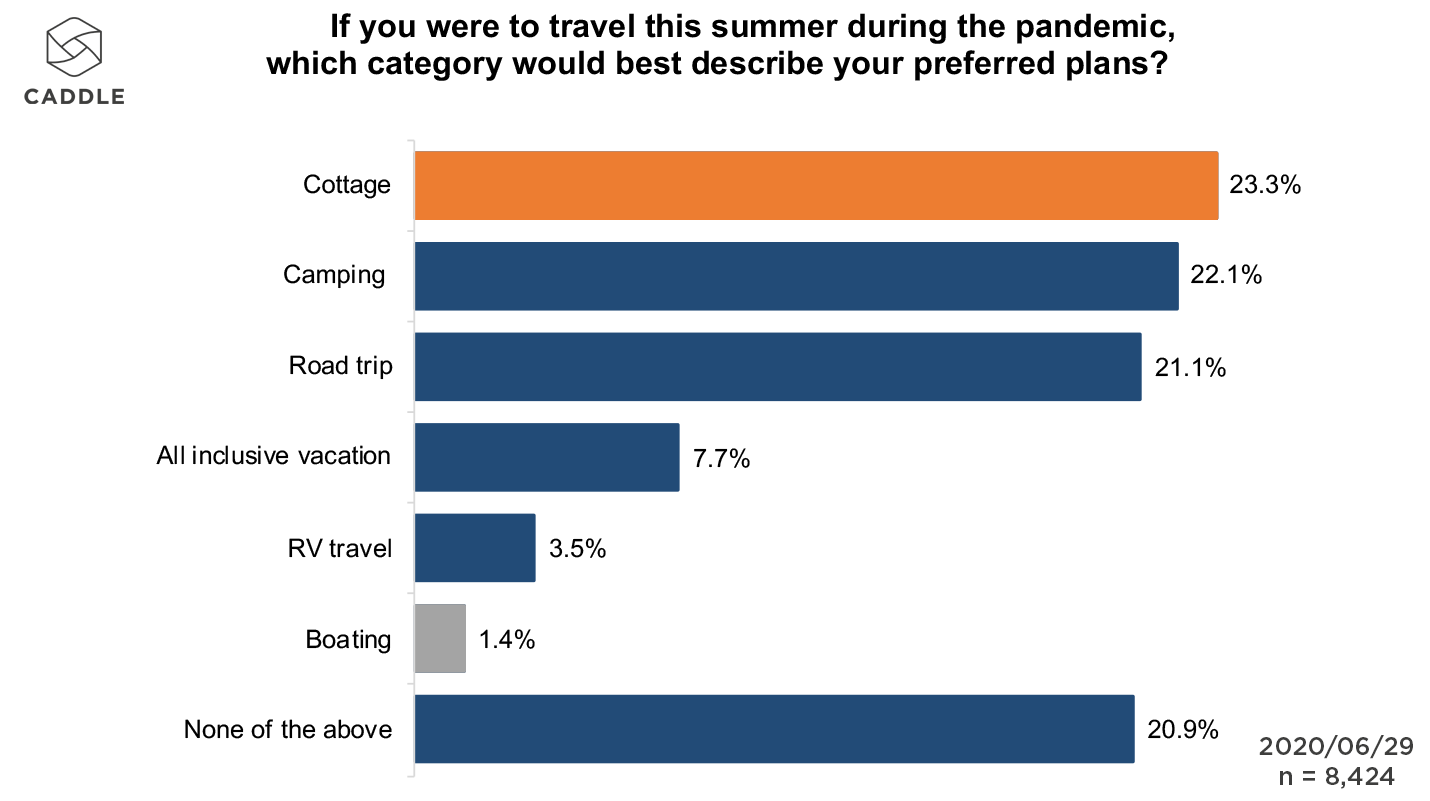
However, it’s interesting to note that these preferences fluctuate by region, which may be indicative of differential access to accommodations and/or local destinations. So, while Albertan respondents prefer camping and road trips (at about 27% each) and Manitobans prioritize camping and cottaging (31% and 23%, respectively), Ontarians prefer cottaging 2x more than camping and road trips and British Columbians and Saskatchewanians rank camping at 2x the rate of cottaging.
WHAT ARE SOME OF THE FACTORS CONCERNING CANADIANS MOST ABOUT TRAVEL THESE DAYS?
On the one hand, respondents are overwhelmingly concerned about contracting COVID-19 while on vacation.
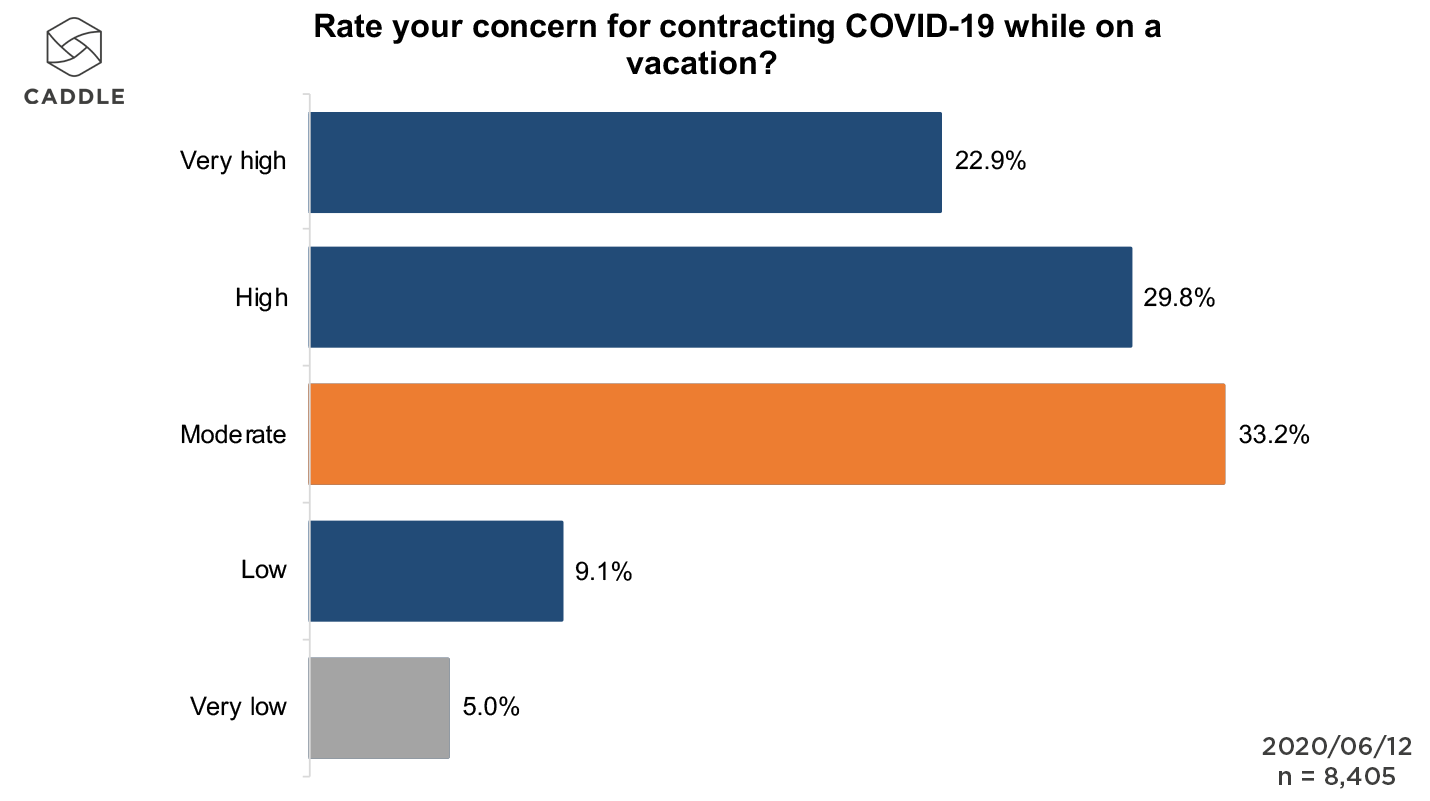
This is consistent across all generations, though the eldest respondents (including those among the Greatest Generation, Baby Boomers and Gen X) over-indexed on “high”/”very high” concerns. This is perhaps most understandable given senior populations’ increased susceptibility to the virus.
Caddle users also overwhelmingly agree that health and safety procedures introduced due to the pandemic would make travel less enjoyable this year, especially Baby Boomers (75%), Gen Xers, Gen Zers and Millennials (72% each) and the Greatest Generation (70%).
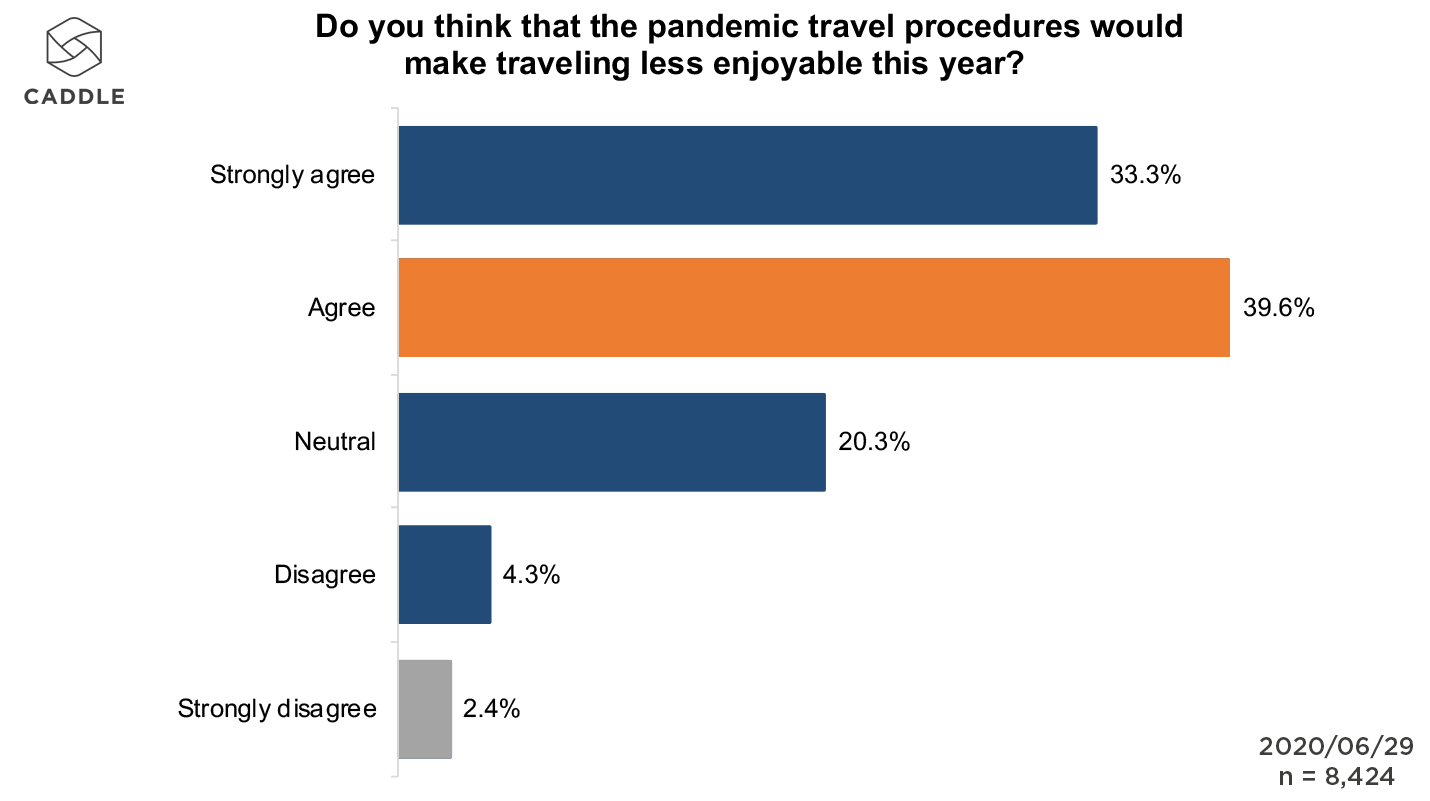
Finally, among those who plan to travel by plane in the second half of 2020, price and sanitation/screening practices rank equally high among their considerations, at 37–9% each.
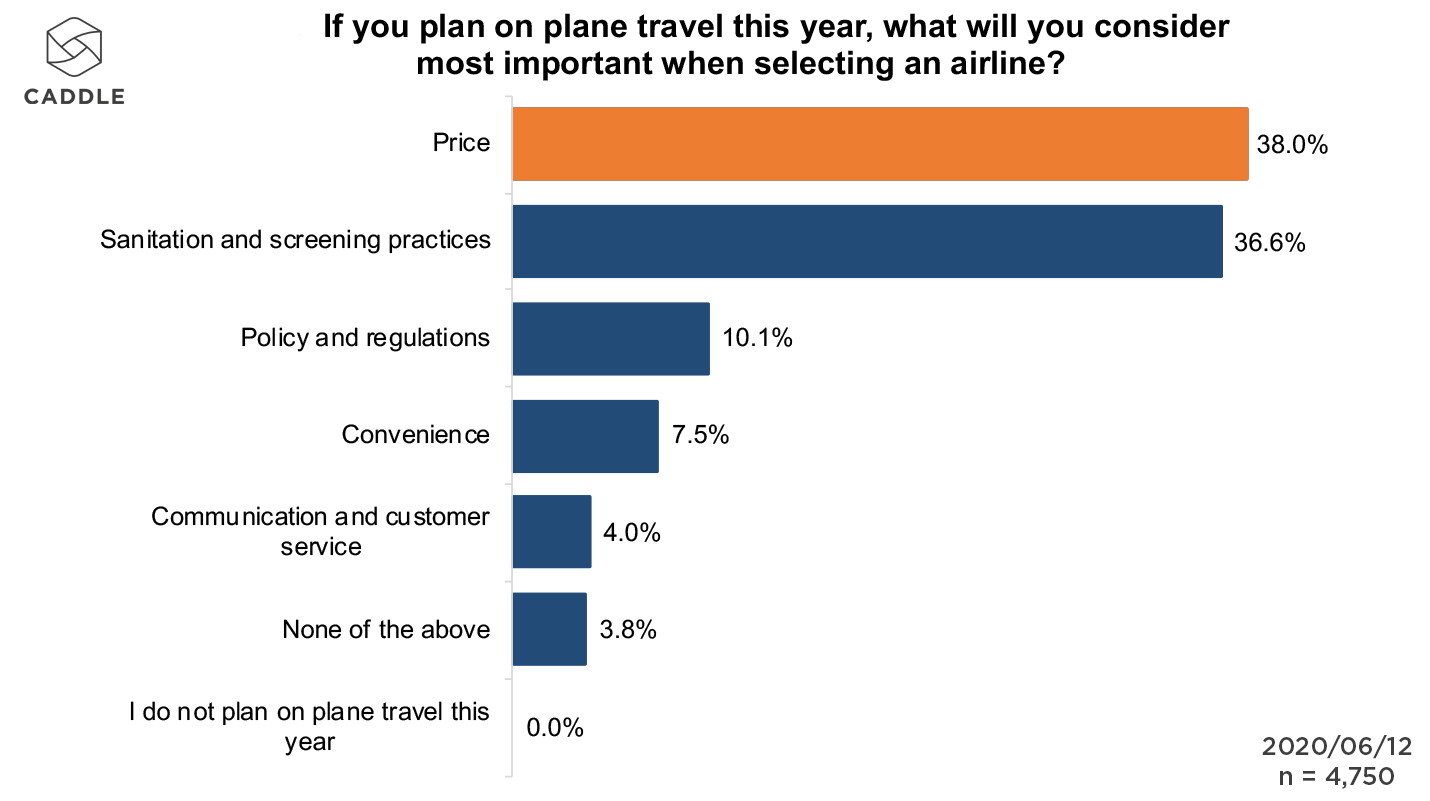
From a regional perspective, Albertans, Quebeckers, Newfoundlanders and Labradorians prioritize price, while Saskatchewanians value sanitation and screening practices more highly.
Taken together, these consumer insights suggest that the international travel industry will continue to have a tough hill to climb to win back Canadian vacationers in the months and possibly years to come.
KEY TAKEAWAYS
CANADIANS ARE WILLING TO “THINK LOCAL” WITH THEIR TRAVEL PLANNING
From campsites to cottages to RVs to Airbnbs, Canadians seem to be shifting allegiances from international travel destinations to ones closer to home.
When you combine respondents’ health and safety concerns with the very real threat of contracting COVID-19 through plane travel, we expect that this trend will have positive implications for the restaurant and hotel industries, tourist attractions, campgrounds and equipment vendors, among many other suppliers across Canada.
HEALTH AND SAFETY ARE TOP CONCERNS FOR TRAVELLERS (BUT SO IS PRICE)
With the pandemic continuing to rage south of the border, it’s no wonder that Canadians are increasingly afraid of contracting the virus. Such concerns are likely to persist through the latter half of 2020 and, no doubt, until a viable vaccine is made available in the coming years.
As such—and even as provincial restrictions continue to ease—it’ll be important for travel and tourist suppliers to keep health and safety standards top-of-mind among their grassroots-level employees, both to keep the chance of contracting COVID at bay but also in order to alleviate potential customers’ concerns.
At the same time, because the pandemic has put a major strain on Canadian populations (particularly when it comes to financial concerns), hotel, airline and travel brands should equally prioritize pricing and value if they’re going to attract those Canadians who are willing to take a vacation in the coming months.
GEN ZERS MAY BE THE LOWEST-HANGING FRUIT FOR CANADIAN TRAVEL AND TOURISM SUPPLIERS
In tandem with their relatively more active pandemic lifestyles and interest in healthier eating, Gen Zers are also more likely than other generations to take non-essential trips by plane in the coming months. This makes them a ripe target for travel and tourism suppliers, especially as restrictions ease and favourite restaurants, attractions and other haunts become more accessible to them.
If you’re looking to win Gen Zers’ travel budgets, remember that they tend to be among the least brand-loyal of Caddle respondents and will switch to cheaper offerings as a way to save money. Thus, a focus on health and wellness at a discount is likely to win a greater share of this population’s spend than sticking to tried-and-true brand messaging.
COVID-19 Insights: Brand-Loyal Alcohol Consumers Ditch Diet Concerns in Favour of Flavour
51% of alcohol consumers never check the nutritional label on alcoholic beverages
Celebrating national holidays looks and feels quite different in 2020 than in years’ past. With many Canadian cities easing quarantine restrictions and hot weather driving more people out of doors, we were interested in understanding whether alcohol consumption patterns had changed in any discernible way over the last four months of lock-down, and what implications that might have on post-pandemic consumption habits.
We learned that, while staying six feet apart and wearing maple leaf–emblazoned face masks in public may have cut into many people’s fun-making this past holiday week, some things haven’t changed: Canadians know what they’re looking for in their alcoholic beverages of choice—with 51% of Caddle users prioritizing taste over nutritional content and 76% staying true to their preferred brands.
As more public spaces open up in the months ahead, we’ll continue to monitor Canadian consumers’ celebratory habits, including their consumption of alcoholic beverages during the hazy days of summertime and beyond. But it’s safe to say, the majority of Canadian respondents enjoy a tipple from time to time, and the stresses inflicted on people due to the pandemic have only served to reinforce that behaviour for about one in five respondents.
Stay in the know on Canadian consumer habits! Sign up to receive our free, weekly summaries.
ARE CANADIANS DRINKING MORE DURING THE PANDEMIC?
Across all demographics, 80% of those who drink are consuming the same amount of alcohol or more, compared to before the pandemic.
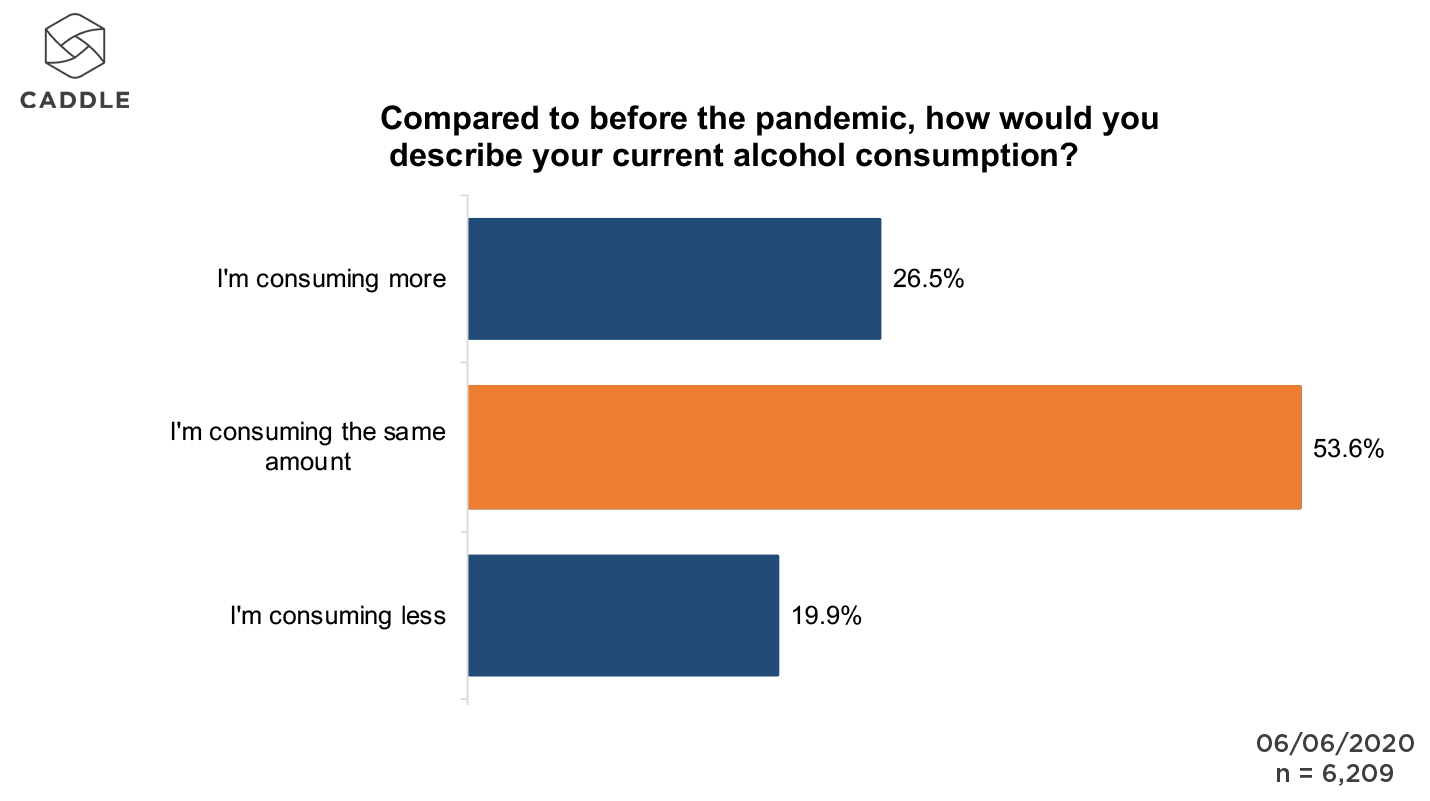
Their spirit of choice? Unequivocally, vodka is most popular among Caddle respondents, at 21%. The next most popular spirit is rum, at 11%, while whisky comes in at 8%. This ranking is consistent across all age and geographical segments, except the Greatest Generation (born 1900–45)—who prefer whisky most, followed by rum and liqueurs—and Quebeckers—who prefer rum most, followed by vodka and gin.
Vodka is also the most popular spirit (39%) among those who reported consuming more alcohol since the pandemic began.
When we look at potential differentiation based on gender, the top three (vodka, rum and whisky) remain the same for both males and females, but while women’s preferences compare positively to the general population—with vodka leading at double the rate of rum—men seem to prefer the three spirits in equal proportion. This suggests that men perhaps enjoy the deeper flavour profile of darker spirits like rum and whisky as much as the lighter flavour of clear spirits like vodka.
HOW BRAND-LOYAL ARE CANADIAN CONSUMERS WHEN IT COMES TO THEIR ALCOHOLIC BEVERAGES?
The simple answer is “very”! More than three-quarters of respondents have stuck with their preferred alcohol brands since the start of the pandemic. This is consistent across gender and age divides, though Gen Zers seem to be more open to trying different brands, compared to other generations.
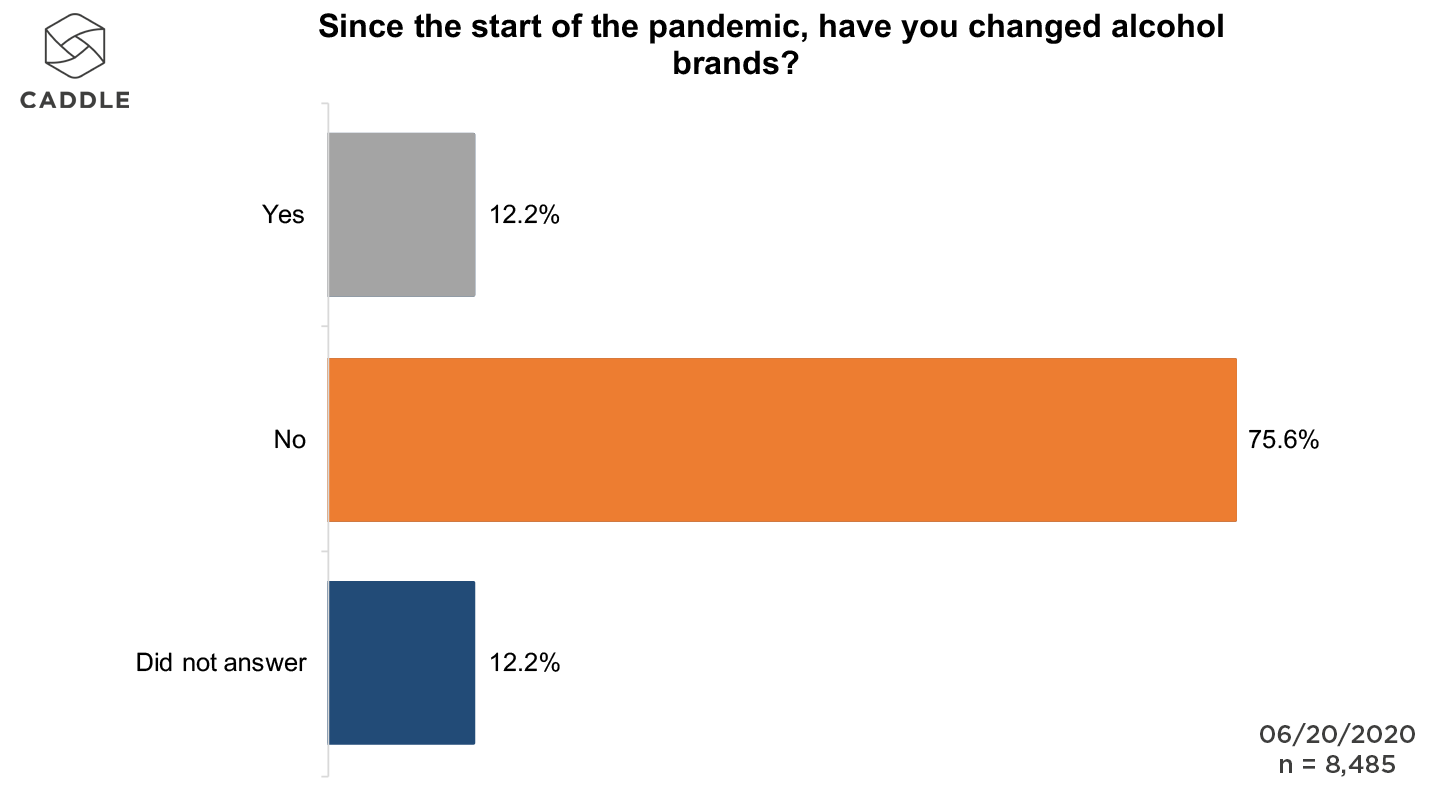
Brand image plays an important role in decision-making around alcoholic beverage purchases for a third of consumers, though an equal percentage are neutral on the subject, across the general population.
Among those panel respondents who have changed brands, 77.5% expect to continue to purchase the new brand after the pandemic.
WHAT OTHER MAJOR FACTORS HAVE AFFECTED CONSUMER DECISION-MAKING ON ALCOHOLIC BEVERAGES DURING THE PANDEMIC?
Broadly speaking, flavour, community consciousness and availability all seem to factor into consumer interest in alcoholic beverages—especially during the pandemic—while nutritional content seems to be the least of consumers’ worries.
So, while 51% or more of Canadian alcohol consumers “never” check nutritional facts listed on alcoholic beverages (Quebeckers over-index at 52%, while Boomers come in at 60%), 61% feel that they should not have to sacrifice great taste when purchasing a low-calorie alcoholic beverage.
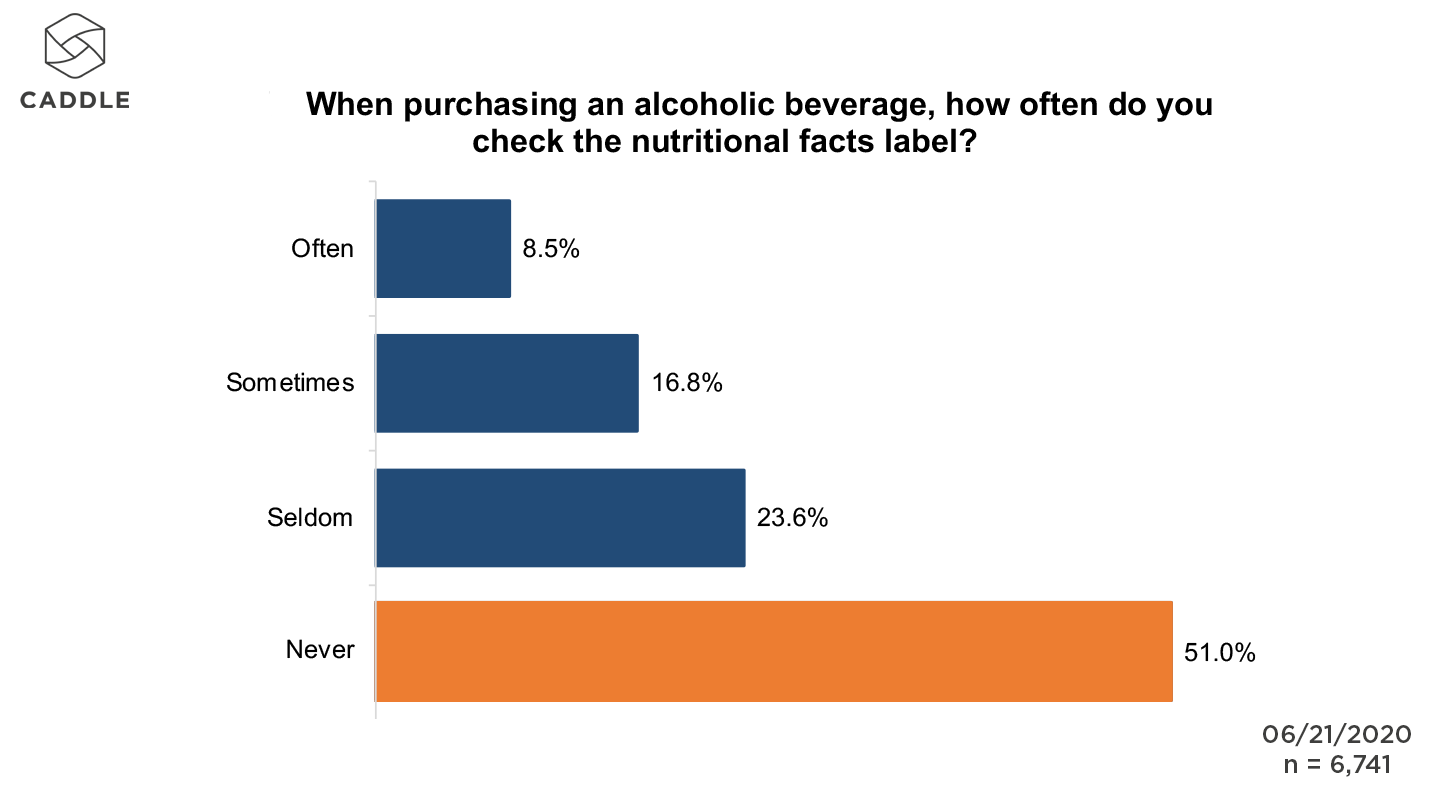

At the same time, 60% reported that they’re interested in purchasing alcohol from companies that provided communities with hand sanitizer during the pandemic (including major international players like AB InBev, as well as independents like Yukon Brewing, Niagara’s Dillon’s Small Batch Distillers, Smooth 42 Craft Distillery in Saskatchewan, Montreal’s Duvernois Creative Spirits and Vancouver Island’s Victoria Distillers), while a little over a third of respondents were indifferent.
And, a further 22% of alcohol consumers on the Caddle panel have been purchasing more alcoholic beverages from grocery stores, compared to pre-COVID times.
Taken together, this suggests that a reasonably sized segment of the Canadian population is open to discovering and trying new brands. And, if those brands deliver value—particularly in terms of flavour or community spirit (pun intended)—even better!
KEY TAKEAWAYS
VODKA EMERGES THE SPIRIT OF CHOICE DURING THE PANDEMIC
Relatively flavour-neutral, and therefore easier to mix with a variety of other ingredients, vodka comes out on top as the spirit of choice among the majority of Canadian alcohol drinkers. (The fact that it also comes with fewer calories probably doesn’t hurt. See Takeaway #2, below.)
The beverage industry should continue to take this to heart and look for new ways to integrate vodka into their alcoholic drink assortment, perhaps leveraging strong brand recognition among compatible mix ingredients (e.g., soft drinks, juices, etc.) to enhance their brand image and influence purchasing decisions. Cases in point: Mark Anthony Group’s White Claw; Constellation’s Svedka Spiked Premium Seltzer; and MillerCoors’ Cape Line and Henry’s Hard Soda.
CANADIANS VALUE TASTE OVER LOW-/NO-CAL CLAIMS
Though a significant number of alcoholic beverage manufacturers, including Molson, Labatt, and numerous craft brands, continue to launch ever-new low- or no-calorie options into the ready-to-drink (RTD) market, their efforts may in fact be better applied to introducing new and enticing flavour profiles to attract alcohol-drinking Canadians.
From a marketing perspective, they’re likely to be especially successful targeting Gen Zers, who are more open to trying new brands, especially during COVID lockdown.
COMMUNITY SPIRIT DRIVES CONSUMER INTEREST DURING COVID
With more than 60% of alcohol consumers expressing interest in purchasing alcohol from manufacturers who pivoted their production to hand sanitizer in the early days of the pandemic, it’s becoming abundantly clear that many Canadians, true to their international image, value community-driven initiatives.
The alcoholic beverage industry in Canada has an opportunity to further entrench the “feel good” nature of their product marketing, taking a page from such companies as Tito’s Handmade Vodka in the U.S. and Brewgooder in the U.K., by giving back to communities that most consume their products.
COVID-19 Insights: The War Against Chronic Pain Rages On for Many Canadians
Chronic pain is the norm for 20% of Canadians, impacting 1 in 2 households across the country
One in five Canadians are living with chronic pain. When left unmanaged, it can lead to sleeplessness, depression and anxiety, lower quality of life, and isolation, and in extreme cases, poverty, homelessness and even suicide.
This is supported by our research, which indicates that 51% of Caddle respondents or someone close to them suffer from chronic pain and related issues:
- 75% of respondents suffer from headaches; 25% of those get them “often.”
- 52% of respondents suffer from migraines; nearly 25% of those experience them “sometimes” and a further 11% “often.”
- 52% of respondents suffer from arthritis pain; almost 10% of those “always” have pain and a further 30% “often” or “sometimes” do.
- 69% of respondents suffer from anxiety.
- 61% of respondents suffer from the blues (i.e., feeling sad and helpless); 30% experience it “sometimes,” while a further 23% deal with it “often”/“always.”
HOW ARE CANADIANS MANAGING THEIR CHRONIC PAIN TODAY?
Unsurprisingly, over the counter (OTC) medication and/or licensed prescriptions are the first line of defense for many Canadians—in part due to the broad availability and overall familiarity with these types of products.
Among the 51% of our 9,000-strong audience who suffer from chronic pain (or have someone close to them who does), almost a quarter manage it using OTC products, while a further 10% take prescribed medication for this purpose.

In terms of medication consumption, the vast majority of Caddle users (84%) are familiar with the benefits of OTC pain relievers, while almost 50% are likely to try new pain relief products. (Among those, Gen Zers in Quebec, Manitoba, Ontario, Alberta and British Columbia are least likely to try new OTC pain products, while Baby Boomers in the Maritime provinces, Saskatchewan and Ontario are most likely.)
And, while only 4.4% of respondents identified cannabis as their method of choice for managing chronic pain, additional survey results indicate that nearly 20% of people would try edible cannabis products based on doctor referral.

Meanwhile, a simple Google Trends or Reddit search uncovers the fact that Canadians are increasingly interested in potential pain-relieving benefits of CBD-based products.

Note, especially, the uptick in searches for “CBD for pain” over the last few months—perhaps an indication of the co-existence of COVID-19 symptoms and consideration of CBD use for muscle aches and pains, or alternatively, reinforcing the use of CBD-based products for the secondary symptoms of chronic pain, such as anxiety and depression, which have been affecting more people under COVID lockdown.

HOW HAS COVID-19 AFFECTED PEOPLE SUFFERING WITH CHRONIC PAIN?
Issues around COVID-19 and chronic pain are beginning to intersect: We’ve learned that COVID-19 can infect just about anybody but is especially dangerous for older adults, young children, and people in marginalized communities. Chronic pain, too, is most common among older adults, children and adolescents, Canada’s Indigenous Peoples (including First Nations, Métis and Inuit populations) and other populations affected by social inequities and discrimination.
Not coincidentally, conditions like depression, anxiety and social isolation have been shown to cause chronic muscle aches and body pain. With the increased incidence of anxiety, depression and loneliness in Canadians due to the financial worry, employment impact and exposure to COVID-19, there’s a high likelihood that people across the country are feeling the effects of the pandemic, both mentally and physically.
If a second wave of COVID hits Canadian communities (as it’s predicted to, in Fall 2020), there could be an interesting synchronization and likely exacerbation of people’s chronic pain and related conditions, especially among increasingly susceptible, older age groups and marginalized populations.
WHAT OTHER THINGS ARE RESPONDENTS DOING TO ALLEVIATE THEIR CHRONIC PAIN SYMPTOMS?
Numerous sources, including the Canadian Pain Task Force, identify various pain management options beyond pharmaceutical interventions. These include modified diet and exercise plans.
Our research bears this out, as the majority of Caddle users indicate they’re likely to take proactive steps towards improving their health, including 48% of respondents who are willing to exercise more often and an additional 31% who are willing to change their eating habits.
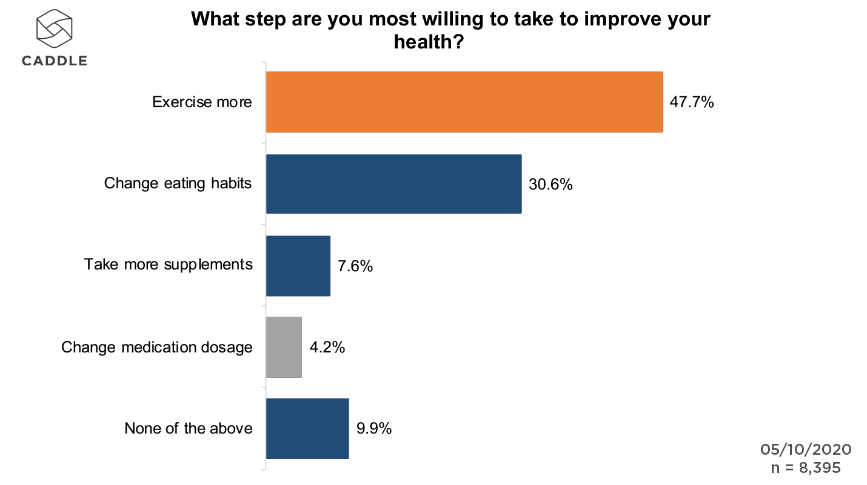
Breaking this down further, over a third of Caddle respondents agree that regular exercise is important to them, and it plays a “moderate” to “very large” role in 62% of respondents’ lives.
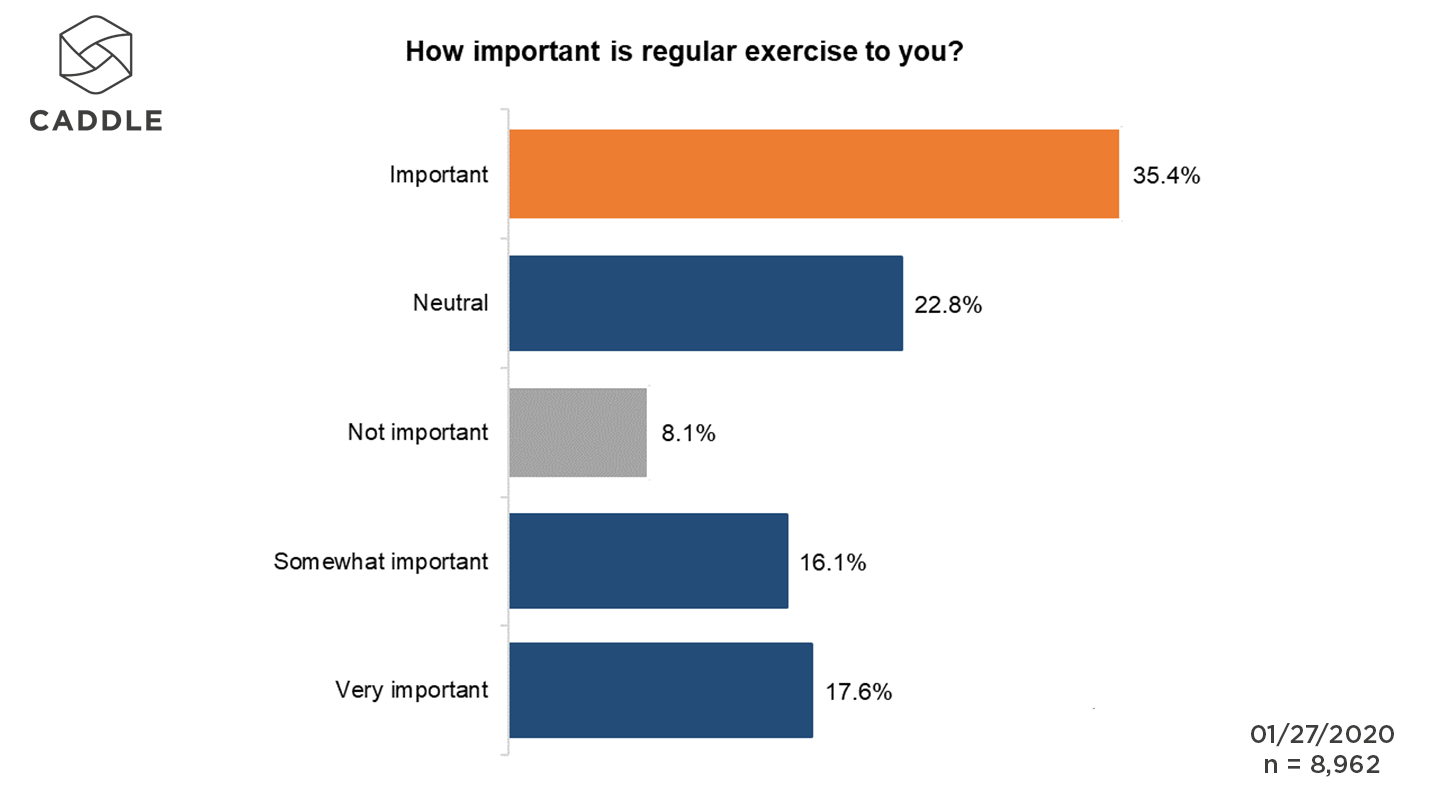

From a healthy eating perspective: We’ve seen that older generations are less likely to change their eating habits. What’s more, the Greatest Generation and Boomers tend to lag behind in their knowledge of diet regimens that can help in the management of chronic pain, such as anti-inflammatory diets.
If older generations are, for the most part, uninterested in adapting their eating habits, and many will continue to medicate to manage their chronic pain, this could result in a nice boom for drug makers—especially those who are able to address the underlying conditions that cause chronic pain as well as the anxiety and depression that tend to plague patients with pain symptoms.
KEY TAKEAWAYS
CANADIANS ARE EAGER TO TRY “NEW” PAIN-RELIEF SOLUTIONS
Whether in the form of prescribed drugs or OTC products, doctor-recommended remedies are still #1 for more Canadians when it comes to managing chronic pain.
Yet, at the same time, certain demographics are open to solutions that fall outside of the mainstream. Taking into account the 50% of respondents who are likely to try new pain-relief products, then, it makes sense that people with friends who consume cannabis products would be more likely to try these alternative solutions without a doctor’s referral.
As such, marketers will need to make a bigger push—and use authoritative data from medical professionals to back it up—if they’re going to see cannabis products pick up a greater share of the pain-relief market moving forward.
CBD PRODUCTS ARE DEVELOPING A MARKET IN PAIN MANAGEMENT
Though CBD isn’t without its own issues, all indications suggest that consumer interest is flourishing, and the category is only going to continue to grow in availability and consumer uptake.
As more cannabis-based products enter the Canadian marketplace, traditional OTC manufacturers will need to keep a keen eye on innovation—watching in-store planograms as well as new products being launched direct-to-consumer on sites like Amazon—to consider how they can stake a bigger claim in the cannabis-for-pain-relief arena.
INCREASED ANXIETY DUE TO COVID-19 IS FUELLING CHRONIC PAIN (AND VICE VERSA)
Even if younger generations are much more likely to transition to a healthier diet and a more active lifestyle—both of which could lead to lower rates of chronic pain—they may still experience symptoms associated with the condition, especially under the unprecedented circumstances dictated by the ongoing COVID scare.
Experiencing frequent feelings of fear, worry and anxiety can impact the body in real ways, contributing to muscle tension and pain.
Marketers who are trying to relieve Canadians’ chronic pain struggles are best to pursue a holistic approach that considers how different generations are affected by both physical and psychological symptoms of pain and how those individuals prioritize the pain-relief options available to them.
COVID-19 Insights: Heightened Awareness of Health and Wellbeing Issues Prompt Better Exercise and Dietary Choices
Almost half of respondents prioritize healthy eating as a result of the pandemic
At a time of year when Canadians would typically be setting their sights on summer activities, for many people, it’s been difficult to look past the troubles that have been brought about by the COVID-10 pandemic. (Take, for instance, the finding that almost two-thirds of Caddle users are foregoing visits to the cottage this summer.)
From vacation plans to shopping habits to food and drug consumption and beyond, COVID has affected just about every aspect of Canadians’ lives and has brought about heightened awareness of health issues—particularly in respondents’ eating and cooking habits, supplement use, and longer-term intentions for improving their overall health and wellbeing.
Get your weekly consumer insights fix! Sign up here for our free summaries, issued weekly.
HAS ANYTHING CHANGED ON THE HEALTH FRONT FOR CONCERNED CANADIANS?
At a high level, it’s safe to say that COVID-19’s ongoing progression (and ever-so-slowly flattening curve) in Canada has only served to increase consumers’ health concerns over time.

Among our 9,538 user–strong panel, three in five people agreed that they’ve become more concerned about their health in the last month.

Add in the fact that 46% of Caddle users have experienced a negative impact on their mental health as a result of COVID-19—extrapolating the effect that such psychological concerns may have on people’s physical wellbeing—and we believe that Canadians will continue to feel the health implications long after the curve has finally flattened. And that includes prolonged effects on people’s mental health.
Said agency health expert Richelle Colbear from Arrivals + Departures: “I think one shift we will continue to see is the increase in conversation around mental health. We will have to see how brands want to be a part of that conversation more.”
Yet, rest assured: we’re not going down without a fight! In fact, based on research from mid-May, almost three-quarters of Caddle users indicated they’re “very likely” or “somewhat likely” to take proactive steps towards improving their health. This is especially the case among older respondents, including Baby Boomers (77%) and the Greatest Generation (i.e., those born between 1900–45; 76%).
WHAT STEPS ARE CANADIANS WILLING TO TAKE TO IMPROVE THEIR HEALTH?
In that same study, we found that Caddle users are prioritizing two key activities in order to improve their health: exercise and food and supplement consumption.
Specifically, nearly half of all respondents (48%) are willing to exercise more often. Meanwhile, 31% of Caddle users indicate a willingness to change their eating habits, and a further 8% will up their consumption of supplements to stay healthy during the pandemic.
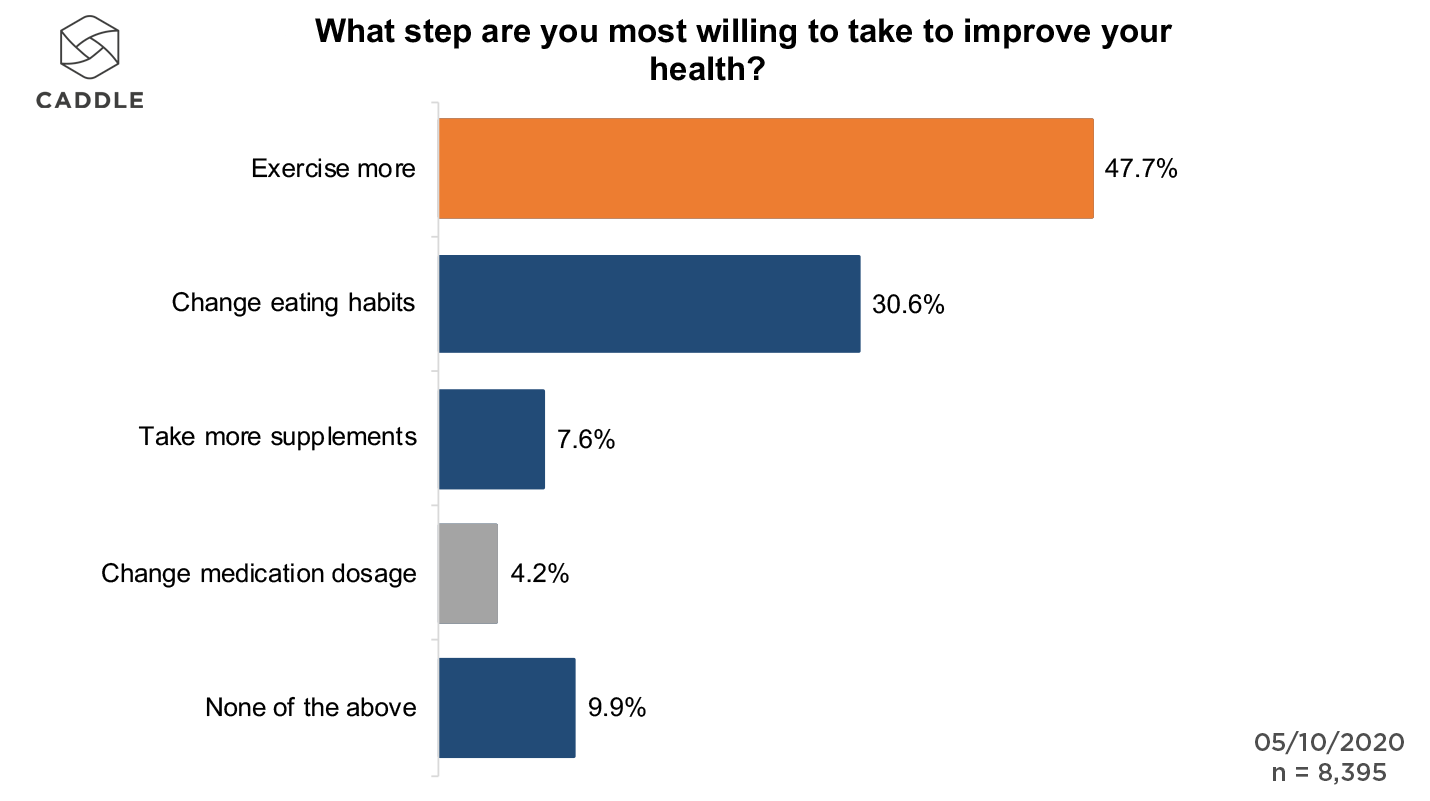
Interestingly, while the Greatest Generation are most willing to amp up their exercise regimen, they’re least willing to adapt their eating. (Admittedly, this could be an indication of the practicality of adding more exercise and nutritious food to their daily patterns.)
Now, let’s take a closer look at each of these—exercise, eating and supplements—in turn.
HOW IS COVID-19 SHAPING EXERCISE HABITS?
While 37% of respondents across the country are concerned about their fitness levels amid social distancing protocols, 43% indicated that they’re maintaining the same level of exercise as before COVID-19 hit Canadian populations. (By comparison, 27% of respondents say they’re exercising “more”/“a little more” and 30% are exercising “a lot less”/“a little less.”)
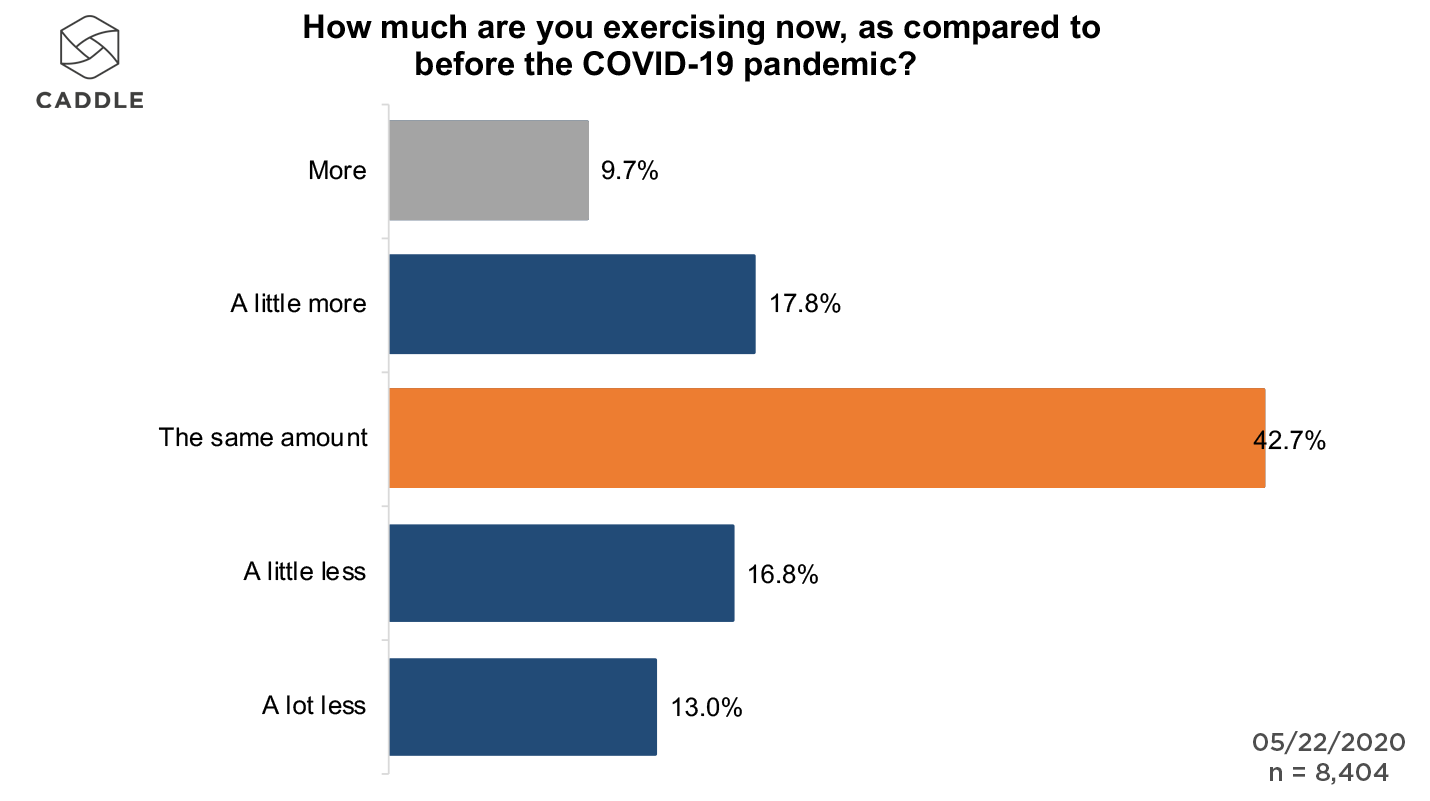
Which segments are exercising most during the pandemic compared to pre-COVID? Gen Zers, for one, almost 40% of whom are “more”/“a little more” active now than before.
Yet, based on that same survey, it looks like the fitness equipment boom that retailers witnessed earlier in the spring may have come to an end: An equal percentage of Caddle users are “very unlikely” as “unsure” about purchasing new home exercise equipment (25.8% and 25%, respectively), while only marginally more users responded positively (“very likely”/”somewhat likely”).
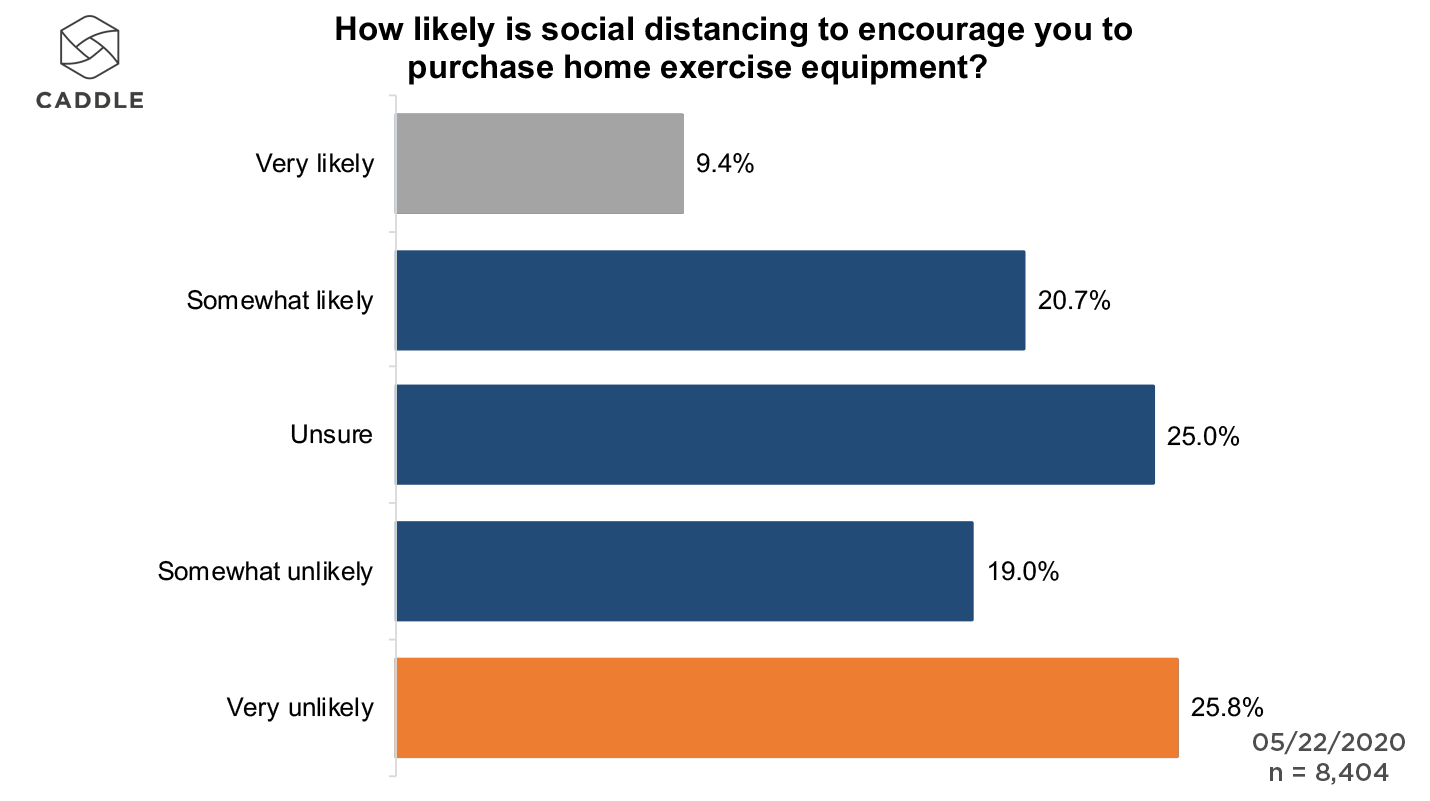
Be that as it may, the athleisure market continues to excel in the face of the social distancing, with nearly 15% of Caddle users anticipating the purchase of leisurewear once stores finally re-open to the public.
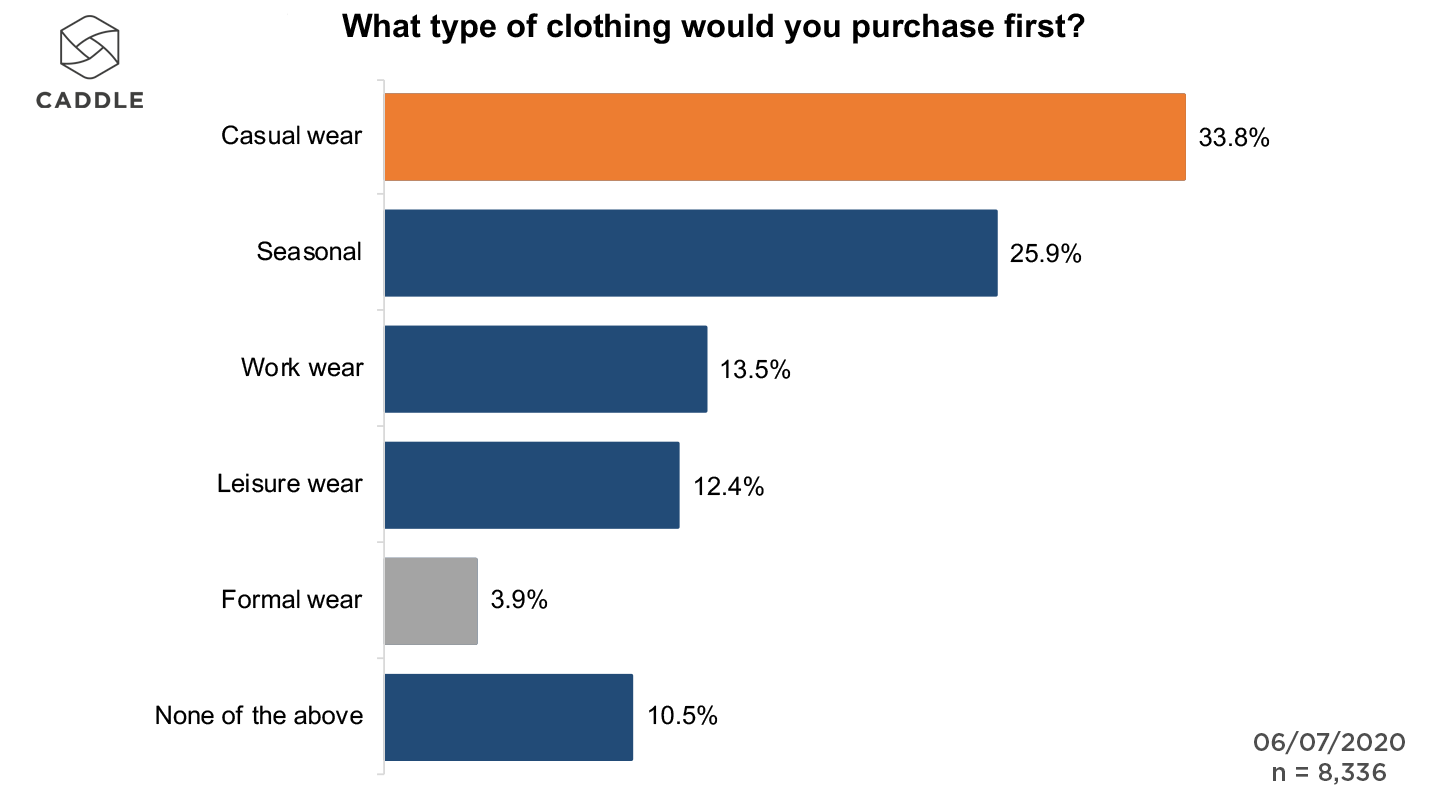
With 69% of respondents indicating that they exercised at home before social distancing curtailed their movement, we can deduce that they’re either not willing to spend their hard-earned cash on what might be considered a non-essential fitness equipment purchase. Or, perhaps they’re already equipped well enough at home to keep up their exercise regimens.
Does this pattern tie into consumption behaviour during COVID-19? Let’s explore the influence of the pandemic on eating habits.
HOW IS COVID-19 SHAPING EATING HABITS?
Based on surveys conducted during mid-May, healthy eating has become more important for almost half of our 8,252 respondents as a result of the pandemic. This is especially the case among Gen Zers located in Saskatchewan (67%), Quebec (63%) and Ontario (61%).
The question then is: Will increased interest in healthy eating extend beyond the pandemic?
Results indicate a resounding ‘yes,’ as almost three-quarters of Caddle users are interested in maintaining healthier eating habits post-COVID. This rises to 86% among respondents who placed greater importance on healthy eating during COVID.
What constitutes healthy eating for Caddle users? In short, a diet with fewer animal products and more fruits and vegetables. So, while 27% of respondents typically consume meat as part of any meal each week, 42% are interested in transitioning to a diet that includes less meat and dairy (Gen Zers are especially interested in going plant-based, at 51%).
At the same time, almost half of respondents expect to consume fruits and vegetables every day of the week.

This is about the same rate of consumption as a year before, though more than a quarter of Caddle users indicate that they’re consuming more fruits and vegetables than this time last year—especially respondents in the Yukon (40%) and Gen Zers in all regions (35%).
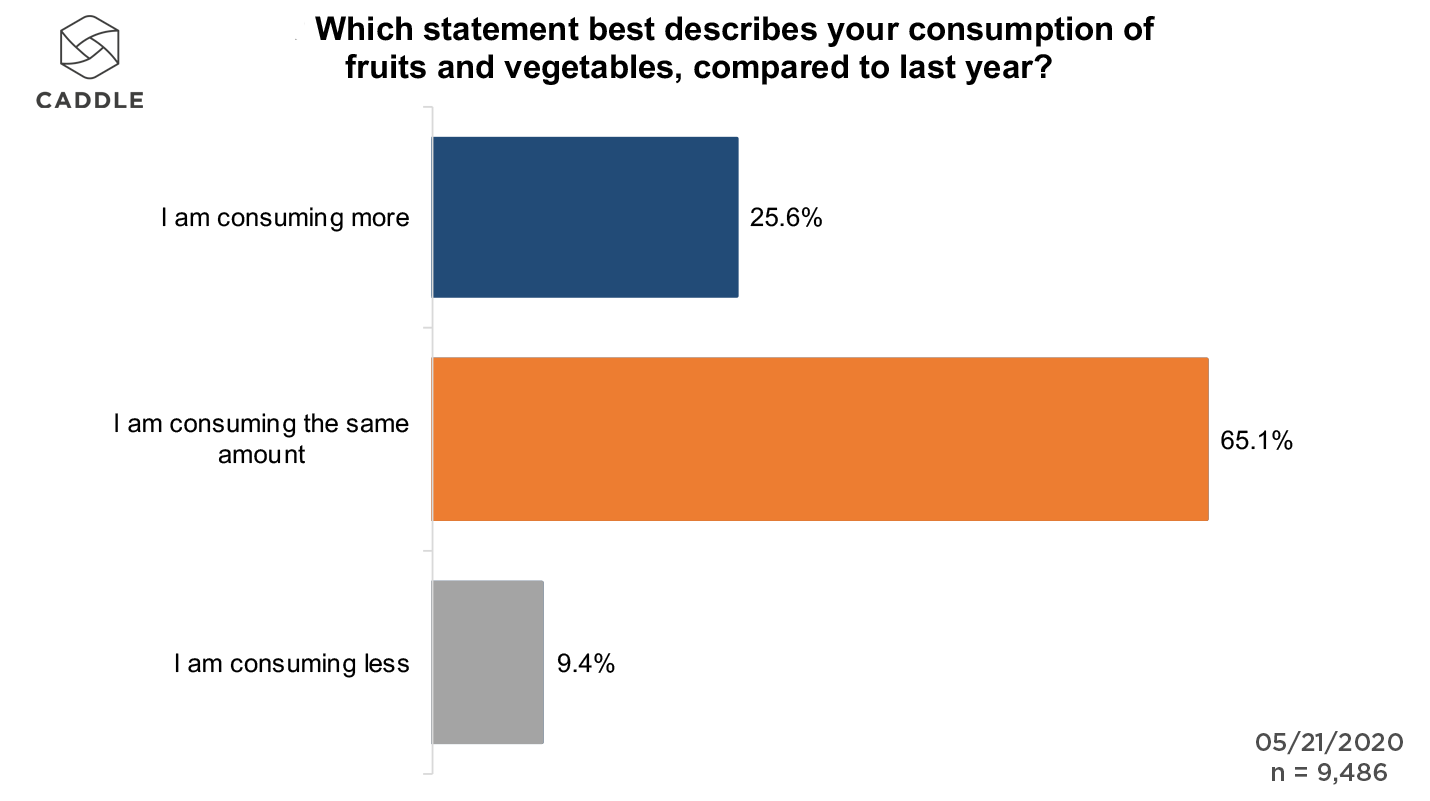
Interestingly, this dovetails with an increasing trend for Caddle users to cook at home more often than before: 100% of respondents who were cooking 1–4 times per week pre-COVID now report cooking 6–7 times per week during the pandemic, and 83% of respondents who cooked 1–2 times per week now find themselves cooking more often at home than before.
Now, with a significant proportion of Canadians opting for healthier food choices, we would expect to also see the same, if not greater, usage of supplements to keep diets as robust and healthful as possible.
Let’s go deeper into the statistics to see if this is the case.
HOW IMPORTANT ARE HEALTH SUPPLEMENTS TO CANADIANS?
Results from a daily survey on June 6th indicate that about 20% of respondents don’t consume dietary supplements. But, of the people who do, 16% expect to increase their consumption in the year ahead, while upwards of 58% expect to use the same amount.
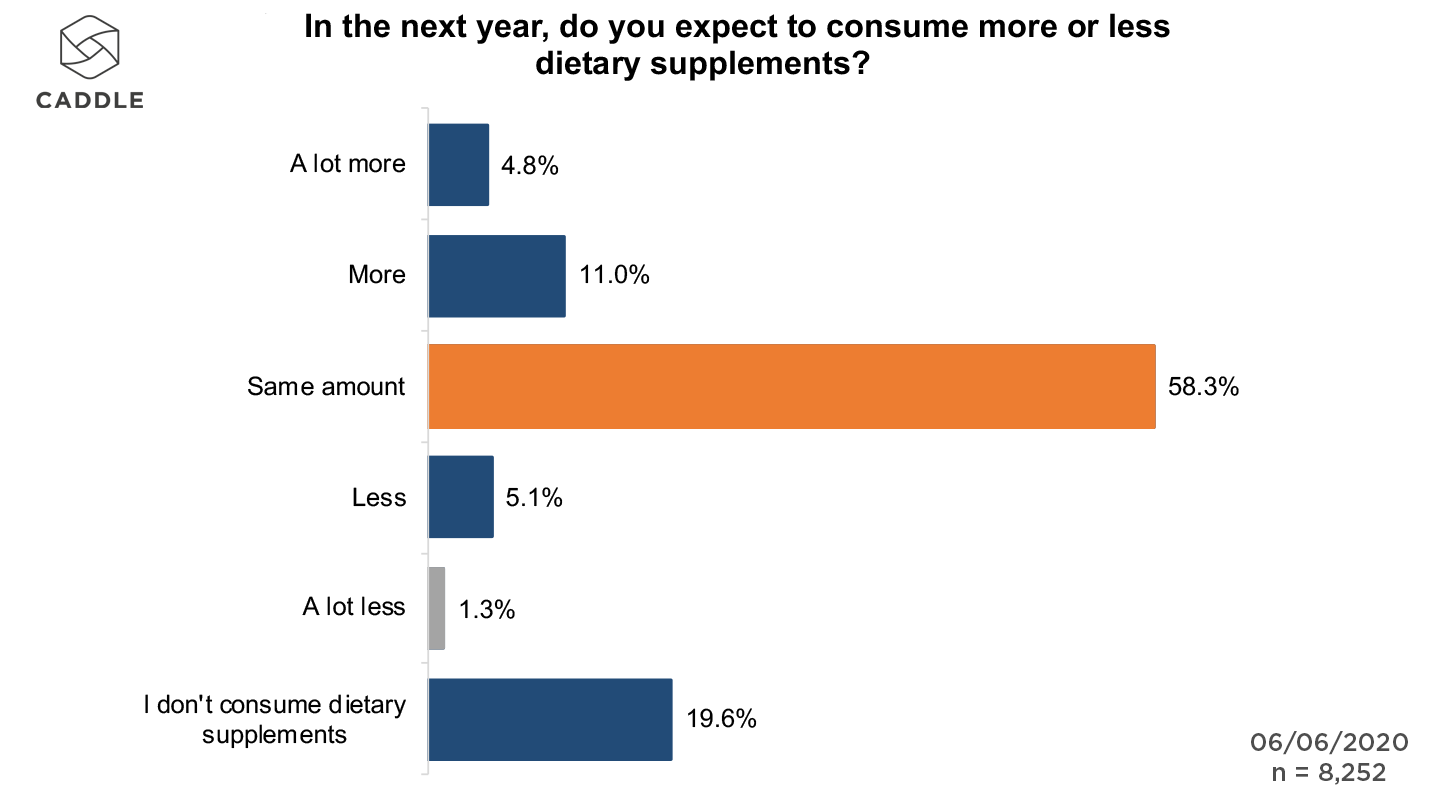
Gen Zers in the Prairies are outliers in this regard: Manitobans expect to increase their supplement consumption by 56%, while dietary supplementation among Saskatchewanians is expected to see a 50% increase in the coming months.
WHAT FACTORS COME INTO PLAY IN CONSUMERS’ HEALTH PRODUCT PURCHASING DECISIONS?
Canadian shoppers’ values differ when it comes to their preferred health and wellness products:
While upwards of 46% of consumers agree that a health brand’s reputation plays a role in their purchasing decisions, 60% of those same Caddle users argue that private label SKUs are just as good as premium-brand health products.
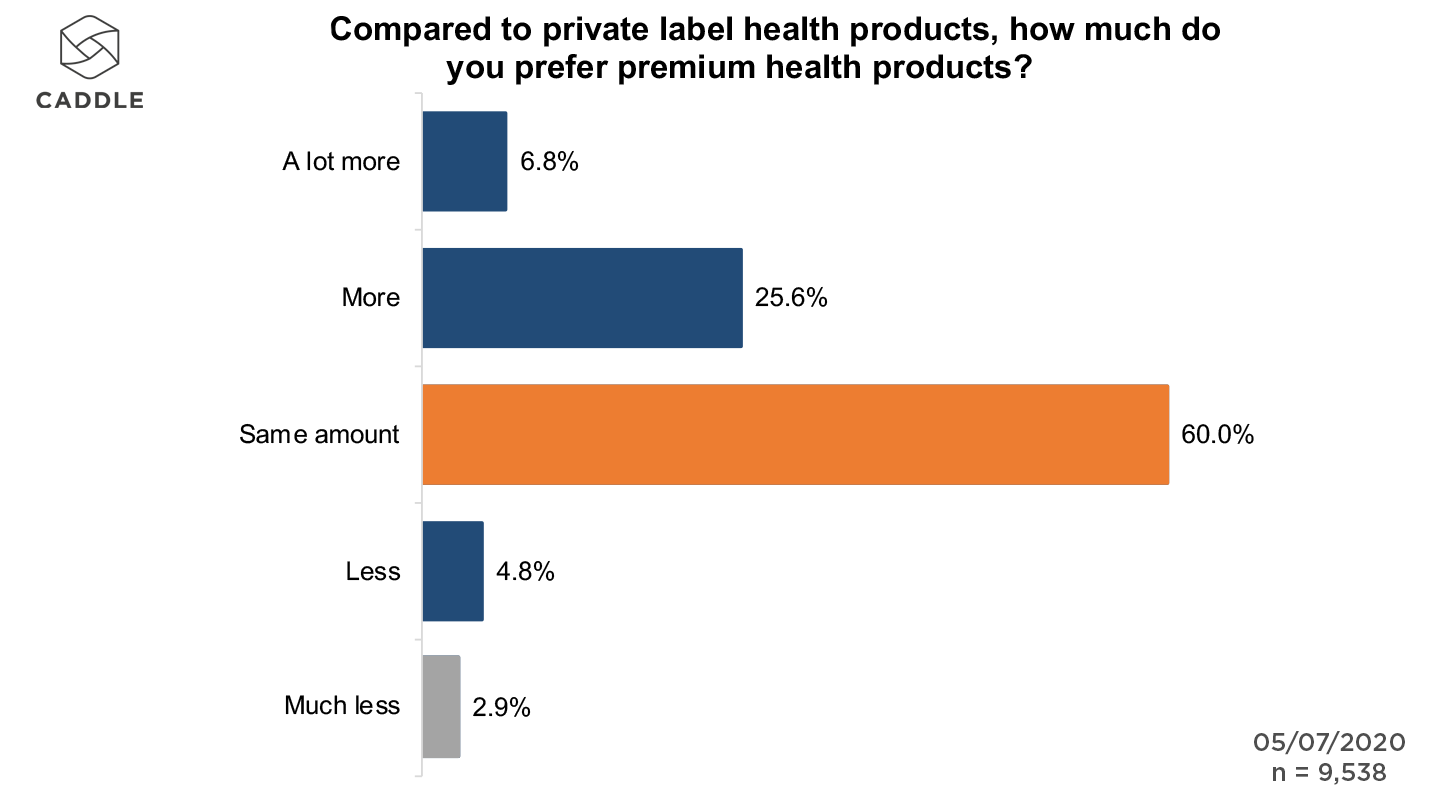
At the same time, premium products don’t seem to sway consumer preferences: Respondents are equally as likely (35.6%) to try new products to improve upon their health concerns as they are unsure (37.3%). (The most likely to try new health and wellness products? Millennials. And the least likely? The Greatest Generation, who perhaps are hesitant to spend money on untested products.)
Health product consumption extends to cannabis-based products, too: Since the onset of the pandemic, cannabis users on the Caddle panel have reported a slight increase in consumption; just over 25% told us that their usage had increased, compared to about 16% who reported a decline in usage.
When asked about the key factors that would prompt people to try CBD products, health benefits came out on top (at 30.7%), followed by doctor’s recommendation (at 20.1%).

This suggests that more Canadian consumers now look to cannabis-based products as an alternative but equally efficacious supplement that’s capable of improving their overall levels of health and wellbeing.
KEY TAKEAWAYS
COVID CONTINUES TO IMPACT CONSUMER WELLBEING (AND THAT’S AFFECTING PEOPLE’S EVERYDAY HABITS)
Amid ongoing concern for their physical and psychological health—as COVID case numbers rise and fall daily across the country—the majority of Canadian consumers are taking proactive measures to improve their overall health and wellbeing.
Whether they’re amping up their exercise regimens, seeking out more healthful food choices (including changing the composition of their diets and cooking at home more frequently), or enhancing their diets with health supplements, more Canadians are taking steps to look after themselves while continuing to social distance.
CANADIAN CONSUMERS ARE MAKING MORE HEALTHFUL FOOD CHOICES (AND IT’S EXPECTED TO STICK IN A POST-COVID WORLD)
With more shoppers now prioritizing product quality, freshness and “shop local” sourcing via farmers markets, it shouldn’t come as too big a surprise that Canadians are shifting away from predominantly animal-based meals and taking a greater interest in plant-rich diets. At the same time, they’re cooking more of their meals at home
While it’s unclear if cooking from home offers greater health benefits, or users are simply avoiding take-out or other meal solutions because of concerns over contamination (or for any number of other potential reasons), the retail sector can gain a stronger share of consumer budgets by catering to the at-home chef who’s looking for healthier food option, now and as COVID restrictions ease.
SUPPLEMENTATION IS A VIABLE METHOD OF MAINTAINING CONSUMERS’ HEALTH AND WELLBEING
A reported 80% of Caddle users use dietary supplements, and that number is expected to increase in the year ahead—particularly among consumers in the Prairie provinces. And while the premium nature of some health and wellness products doesn’t seem to sway consumers into increased purchases, brand reputation does.
This presents a novel opportunity for retailers and manufacturers alike to invest in strengthening the health and wellness claims on their products (both branded and private-label), to continue to drive consumer uptake through the tail end of the COVID pandemic and after.
COVID-19 Insights: Canadian COVID Concerns Rise as Stores Re-Open
52% express negativity about stores re-opening
With findings from mid-May indicating that COVID-19 has had a decidedly negative effect on Canadians mental health, we would expect to see shoppers eager to get back to their pre-pandemic ways of life—including heading back to brick-and-mortar stores to get their retail fix.
However, data from our 10,000 daily survey respondents suggests that Canadian consumers are still wary of stores re-opening if there’s any lingering concern over a COVID-19 resurgence.
And that hesitation continues to have an influence on Canadian consumers’ shopping habits, with a third of respondents expecting to use curb-side pick-up services even after stores have re-opened.
Let’s dig into this week’s data in greater detail:
If you’re not already on the mailing list, sign up here for our free weekly summaries.
IS IT TOO SOON FOR STORES TO BE RE-OPENING?
Based on our research, more than half of Canadian consumers have negative sentiments about the loosening of store restrictions: Almost 50% of respondents overall indicated they are “nervous” or “anxious,” while a further 3.6% are “overwhelmed” by the thought of retailers re-opening their stores while there’s still a threat of a COVID-19 resurgence.
In contrast, about 37% feel positive sentiments about retailers’ re-opening efforts.
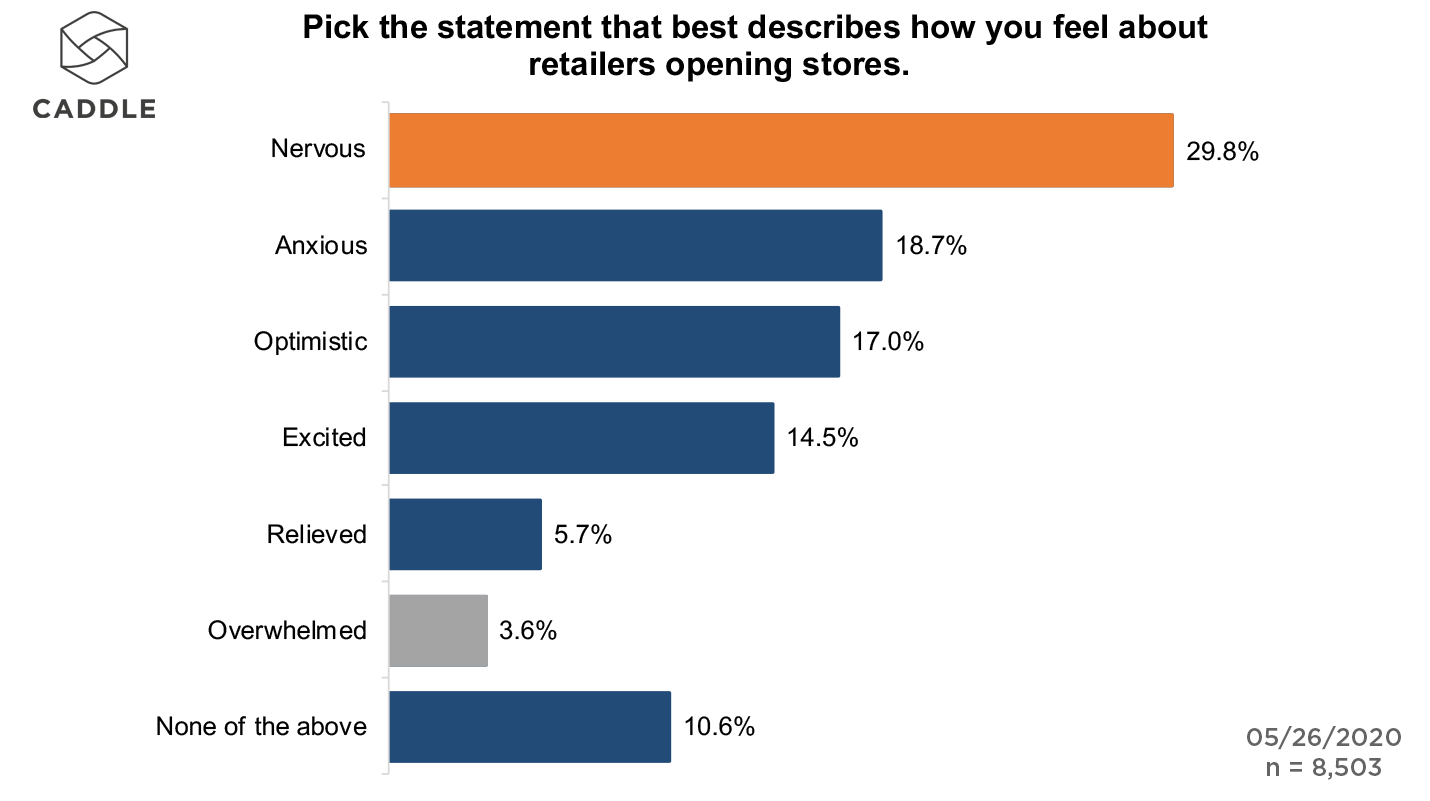
These findings could be further indication of the negative impact that COVID has had on Canadians’ mental health. Yet, when we look deeper into this week’s results, it’s clear that other factors are at play as well.
WHAT’S HOLDING CONSUMERS BACK IN THE RETURN TO BRICK-AND-MORTAR RETAIL?
Cleanliness is one factor. In general, more than a quarter of respondents don’t trust retailers to keep high-touch surfaces clean.
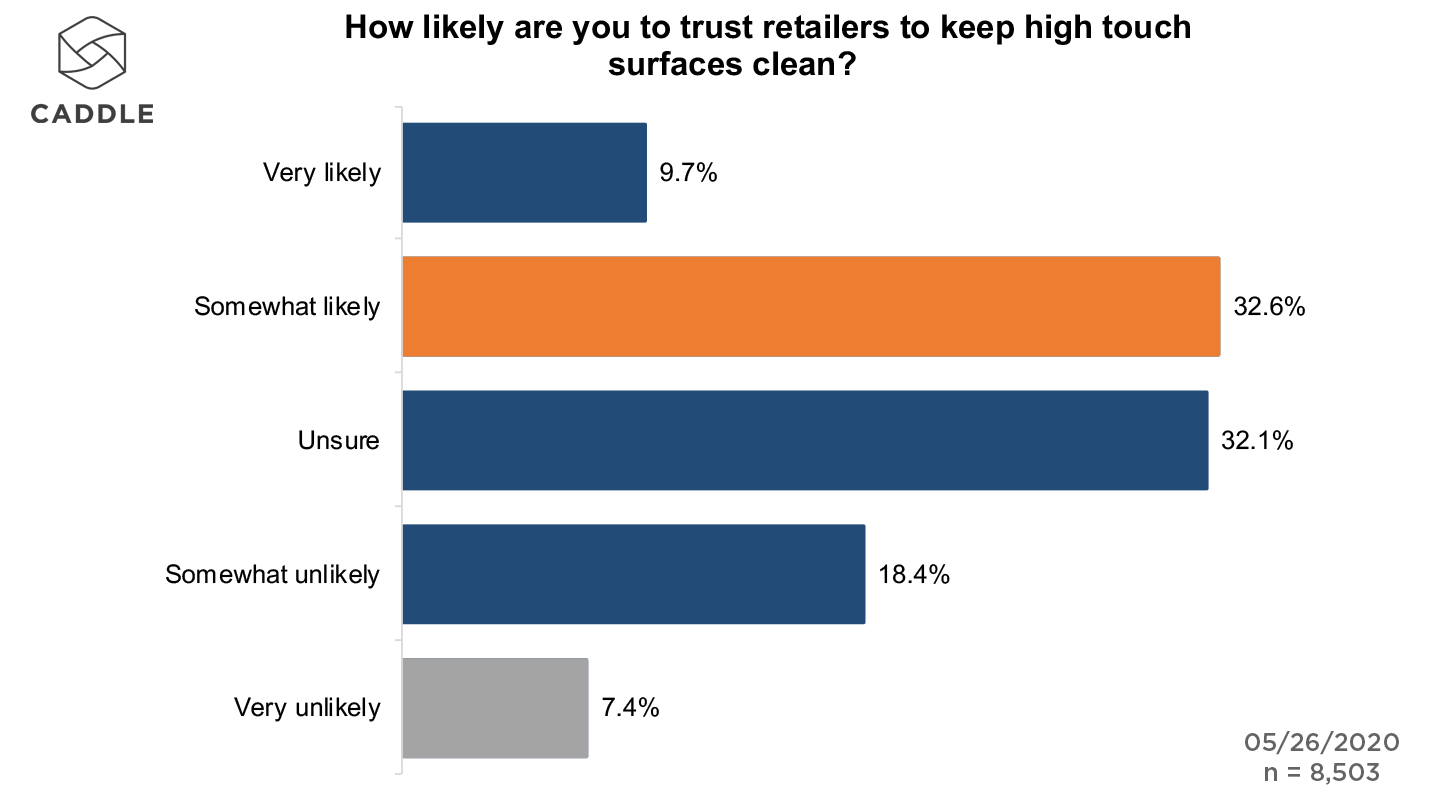
Among these respondents, Millennials are least likely to trust retailers’ cleaning practices (28.5%), followed closely behind by Gen Zers (27%). Meanwhile, while Gen Xers (23%) and Baby Boomers (22%) are slightly more trusting overall.
With some consumers still leery of getting back to shopping in brick-and-mortar stores, it leads us to consider whether consumers will continue to favour online shopping—and in particular, curb-side pick-up options—even after legislation allows for progressive store re-opening.
WILL CONSUMERS STILL USE CURB-SIDE PICK-UP AFTER STORES RE-OPEN?
Based on our research, a significant portion of shoppers are satisfied with their curb-side pick-up experience, with 35% of Caddle respondents indicating that their most recent experience was “excellent” or “above average.” (Interestingly, New Brunswickers, Newfoundlanders and Labradorians skew even higher in their interest in curb-side pick-up, at almost 42% each.)
Yet, even so, consumers seem divided on whether they expect to use curb-side pick-up services after stores ease restrictions: About a third of respondents overall agreed that they would, while a slightly larger segment (36%) admitted that they were uncertain.
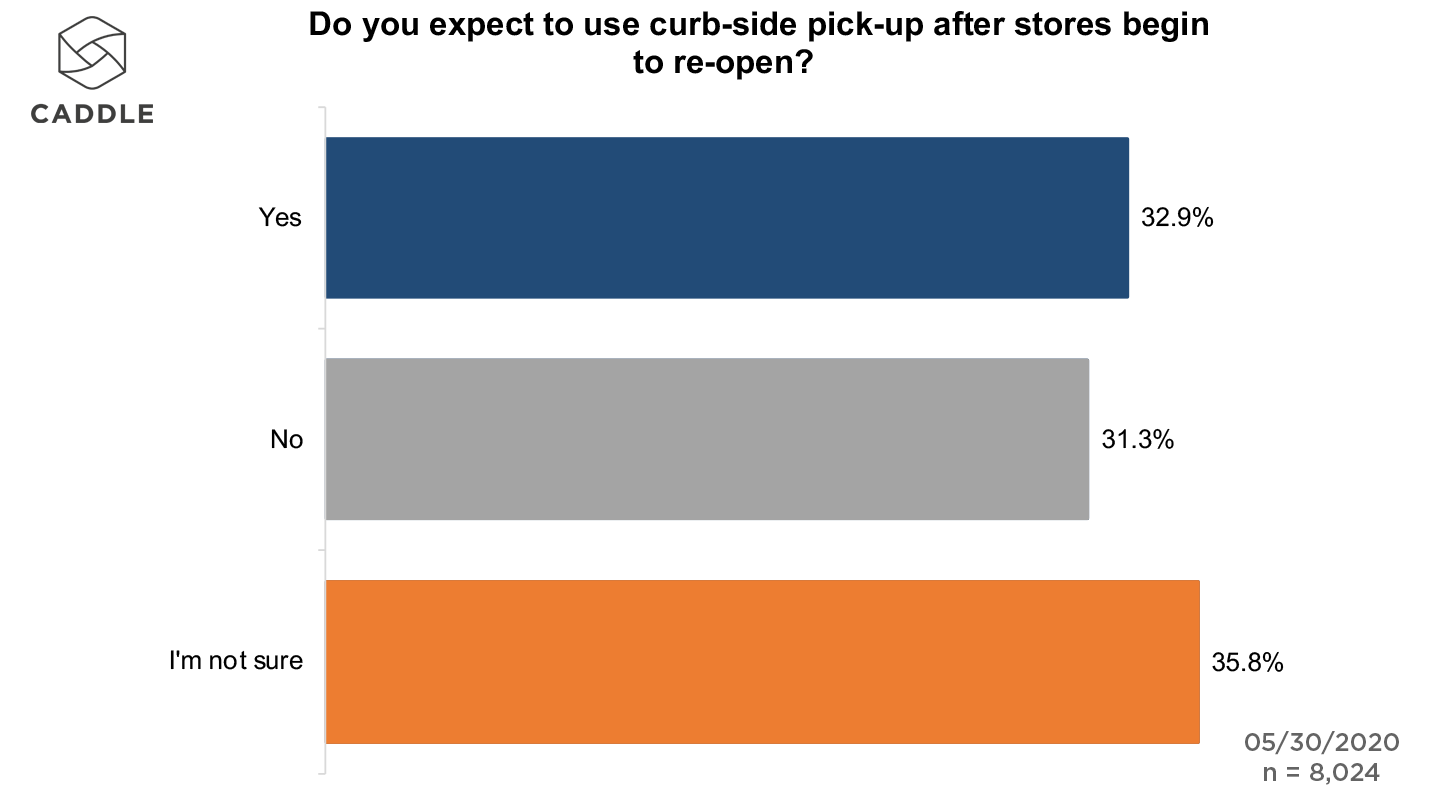
Among these respondents, Millennials are most likely to continue to use curb-side pick-up (38%), while Gen Zers and the Greatest Gen (born between 1900–45) are least likely (at 41% and 39%, respectively).
WHAT WOULD LEAD SHOPPERS TO ADOPT CURB-SIDE PICK-UP OVER THE LONG TERM?
Faced with obstacles when using curb-side pick-up—including long wait times, lack of order accuracy, and length of time between placing and picking up orders—Caddle users identified several factors that come into influence their decision-making around using curb-side pick-up instead of online purchasing with delivery.

From delivery charges tacked on to digital orders (33%) and expected delivery time (25%) to inconsistent products being made available via the different services (almost 20%), it’s clear that retailers have an opportunity here to give consumers more of what they want from their shopping journey, whether that involves delivery to their homes, curb-side pick-up, or buy-online-pick-up-instore (BOPIS) as restrictions ease on brick-and-mortar visits.
If that’s the case, then, we’d expect to see increased consumer willingness to support retailers who are working harder to provide a better customer experience. Indeed, this extends to other pain points that consumers experience from click-and-collect and curb-side pick-up.
Take, for example, the product assortment available to shoppers during the COVID-19 lockdown: A quarter of respondents indicated that they’re unwilling to forgive brands who are producing more single-use plastic due to the pandemic’s safety precautions. (Quebecers are the least forgiving, at 35%, while respondents in the Maritime provinces and Canada’s northern territories are most forgiving.)
Further, product and service quality can be hit and miss with curb-side pick-up, which might explain why such factors as quality and the “shop local” trend each influence about 35% of Caddle respondents to shop at farmers markets, where “farm-to-table” freshness and seasonality are prioritized.
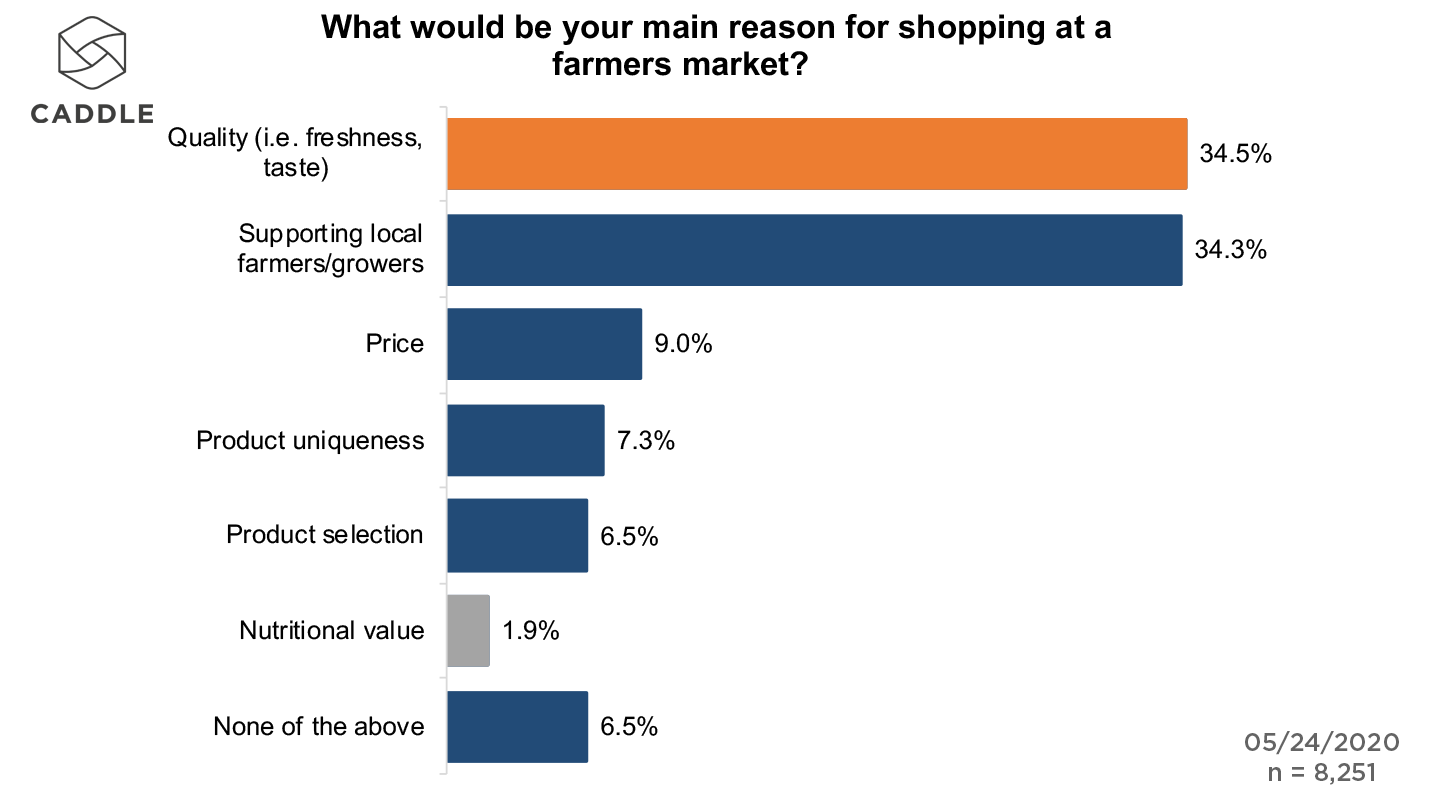
The question then is: What are the implications of ongoing COVID-19 restrictions on non-essential purchases?
HOW HAS THE PANDEMIC AFFECTED NON-ESSENTIAL PRODUCT PURCHASES?
According to our research, 50% of respondents have been forced to abandon a non-essential purchase due to COVID-19, and only 34% of those respondents who abandoned a non-essential purchase put that money in savings, while almost 25% plan to save the money until the purchase becomes available in the future.
With almost 72% of non-essential purchases coming in at an average of $0–300, we can conclude that retailers should expect a reasonable windfall of discretionary purchases to take place once consumers feel confident that the pandemic is firmly under control and stores begin to open up more broadly across the marketplace. (This is further supported by our findings from May 8, 2020, wherein 31% of respondents across our 9,273-strong sample indicated that they were planning an online shopping spree over the next month.)

KEY TAKEAWAYS
CANADIAN CONSUMERS ARE DIVIDED ON THEIR PREFERRED SHOPPING EXPERIENCE AS COVID-19 RESTRICTIONS EASE
Not all consumers are ready to head back to brick-and-mortar stores—especially those who have concerns about retailers’ abilities to keep surfaces clean during a potential resurgence of the pandemic.
A sizeable swath of Canadian consumers have taken up curb-side pick-up in place of in-store shopping, and a third of those shoppers expect to use curb-side pick-up even after stores begin to re-open—suggesting that retailers will need to be hypervigilant about delivering as many positive customer experiences as possible to keep consumers shopping in their stores, whether online or, as restrictions ease, in-store.
TRADITIONAL BRICK-AND-MORTAR RETAILERS CAN LEARN FROM LOCAL SELLERS
Shoppers who prioritize product quality, freshness and “shop local” sourcing are supporting farmers markets with greater frequency.
Traditional brick-and-mortar retailers can take a page from farmers markets’ playbooks, by prioritizing the quality and availability of their products and services, while also working to keep prices down (including delivery charges) and using less single-use plastics while doing so.
SOME NON-ESSENTIAL PURCHASES ARE BEING DEFERRED, BUT THEY’RE NOT NECESSARILY BEING CANCELLED FOREVER
Though a significant number of consumers have had to abandon non-essential purchases because of the pandemic, the dollars they would have spent aren’t necessarily going away for good. Instead, Canadian consumers have deferred those purchases—which means that retailers may see a return of non-essential purchases, as stores open up and greater product assortment hits shelves in the months to come.
COVID 19 Insights: Growing Isolation Blues
-46% Canadians say pandemic has negatively impacted their mental health
The images of a packed Toronto park this weekend showed how easily social distancing discipline can slip for some Canadians.
While the warm weather is a likely cause of people dropping their guard against COVID-19, the deeper question is why people would decide to take the risk in the first place.
The answer might lie in the growing emotional toll of social distancing. Data from our 10,000 daily survey respondents shows that half of young people feel COVID-19 has had a negative impact on their mental health.
What’s more, they are more concerned about the impact of social isolation than of actually contracting the virus.
We saw last week how Canadians are turning to retail therapy in the search for positive experiences during an emotionally difficult time.
In this context, is the flaunting of social distancing rules another manifestation of this trend?
Here’s what we found this week:
How is COVID impacting mental health?
Across all demographics, the pandemic is having a clear negative impact on mental health of Canadians. 46% of Canadians told us that COVID-19 had caused a negative impact on their mental health.

This figure goes even higher when looking at specific groups. Women are more likely to report negative impacts than men (48.6% vs 38.5%) while those under 40 were slightly more likely to identify adverse impacts on their mental health (48.4% vs 44.7%).
This may not necessarily be something that will resolve itself once governments lift restrictions. Just over 40% of those who said that the pandemic had a negative impact on their mental health also said they anticipated that COVID-19 will have a long-term impact on their mental health.
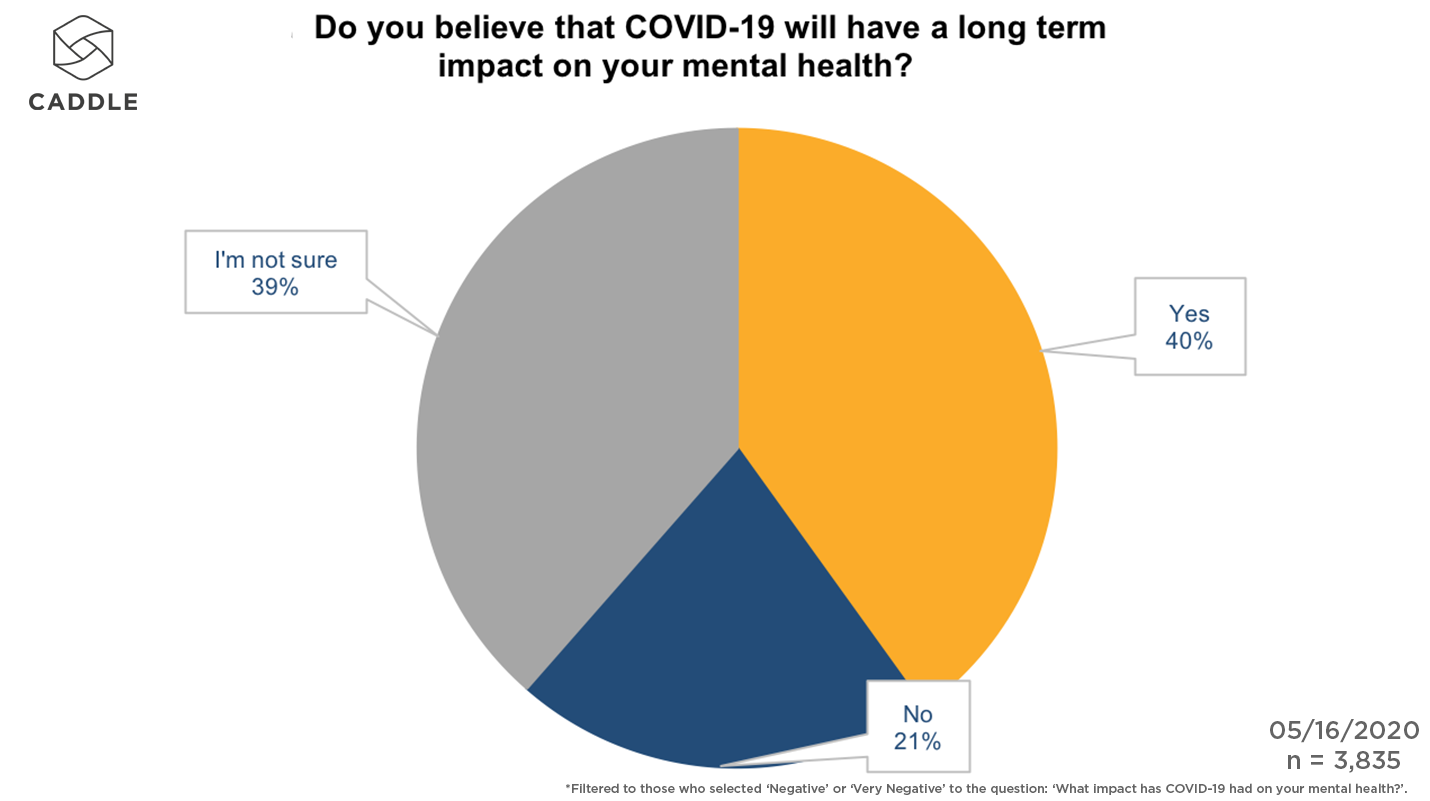
What is causing the trend?
There is no single factor that defines of Canadians’ COVID concerns. However, our data shows that this clearly goes beyond the direct health implications of the pandemic.
Asked what concerned them most about COVID-19, 37% selected either the fear of contracting the virus themselves, or the loss of a family member.
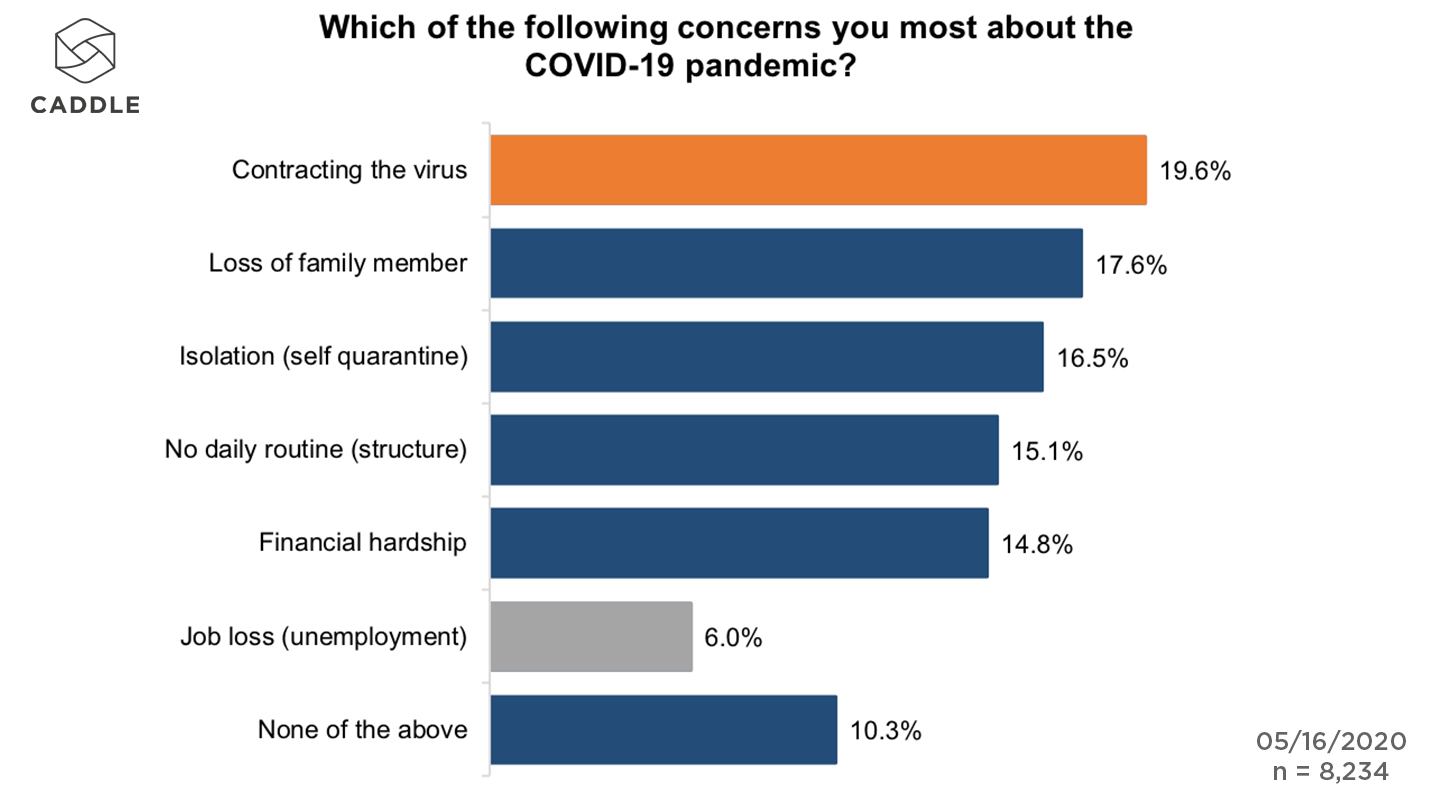
Meanwhile 46% identified broader socio-economic reasons as their biggest concern about the pandemic. These are factors such as isolation, lack of daily routine, and financial hardship.
When looking at those who reported negative mental health impacts, this trend becomes more pronounced. 51% of this group selected these socio-economic impacts as their biggest concern rather than contracting the virus or losing a family member.
Now looking at Canadians under 40 who reported negative mental health impacts, 20% say social isolation is their biggest concern with COVID-19 compared to 16% concerns about actually getting the virus.
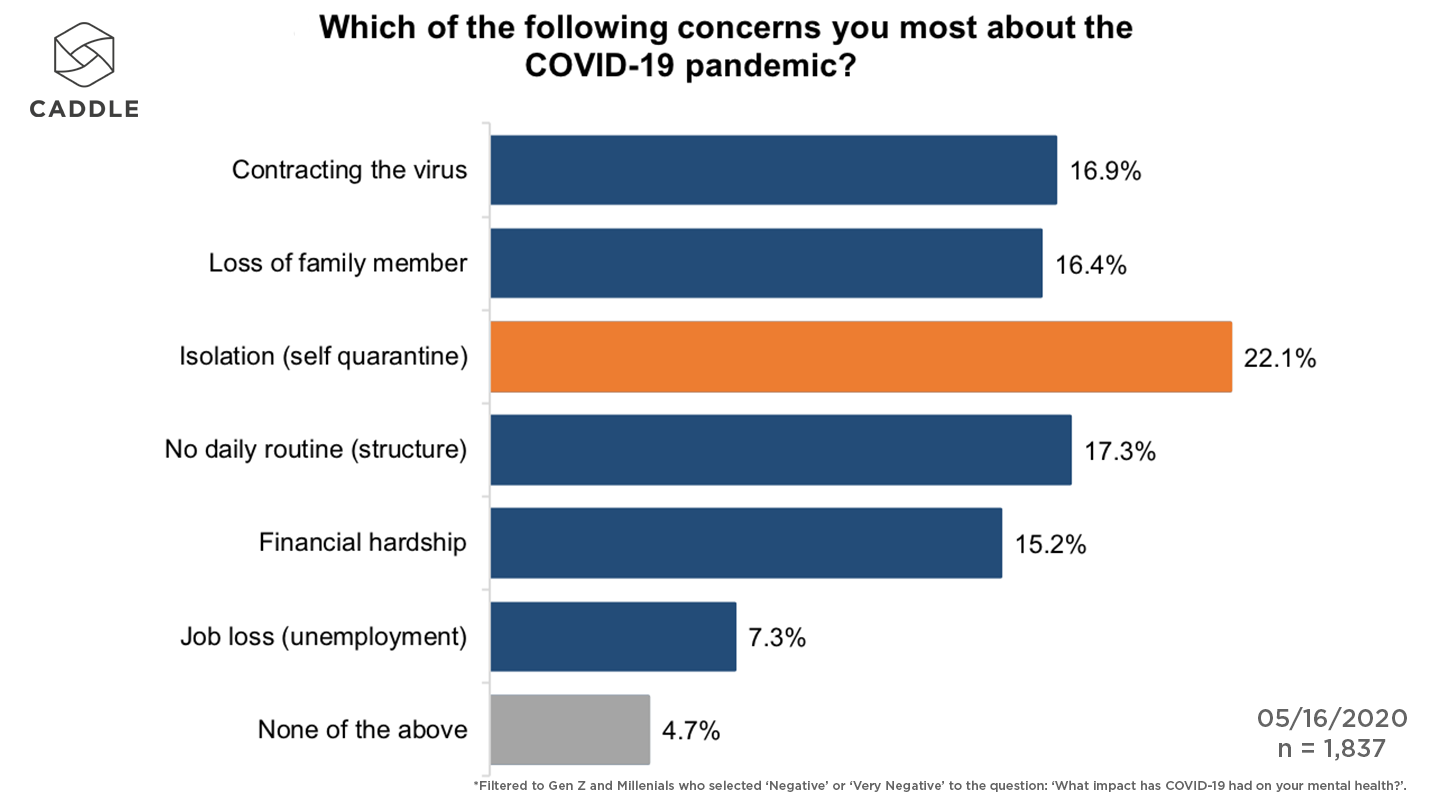
This lays bare the challenge governments face as we past the initial phase of the pandemic.
New daily cases have come down, and as a result we have seen anxiety over the virus come down.
While overall our data suggests broad support and adherence to guidelines, getting unanimous buy-in to distancing protocols may become more challenging, despite the threat of a second wave being very real.
Is social media a positive or negative?
With Canadians cut off from seeing friends and family, social media offers an opportunity to keep people connected. However, what seems to be happening is the opposite. If social media is having any impact on the mental health of Canadians, it is a negative one.

Again looking at those who reported a negative mental health impact due to COVID-19, we see that 40% said that social media had impacted their mental health in a negative way during the pandemic.
One possible explanation for this is the overload of content relating to the pandemic that Canadians encounter on social media. After all, this has been a ubiquitous issue in conversations and media coverage for over two months.
After so long, it is possible that Canadians have reached saturation point with pandemic content. In a separate survey, we found that 34% of our panel actively avoided COVID content.
What does this mean for brands?
This data shows that brands need to tread very carefully when it comes to messaging during COVID-19.
Not only is COVID overload a potential factor, but Canadians are wary of brands using the pandemic as a platform for advertising.
38% said they would be disappointed if their preferred brand used the pandemic for advertising purposes. Meanwhile just 20% said a COVID advertising campaign would encourage them to support a brand.
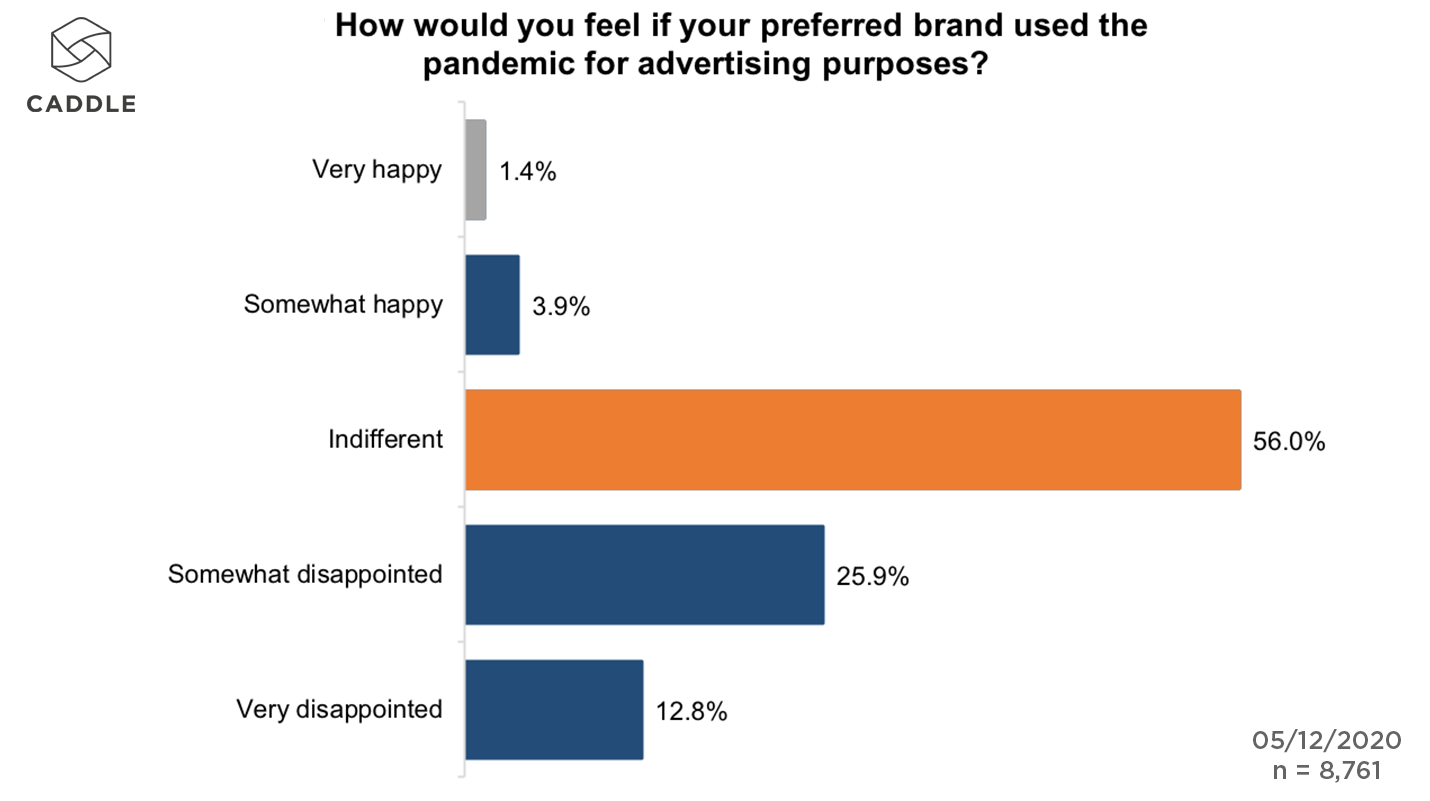
Key Takeaways
Isolation is beginning to grate
The decline in anxiety over coronavirus suggests that, rightly or wrongly, we perceive it as less of a threat right now.
Even if it is only a small minority who break social distancing guidelines, the broader concern many Canadians feel about the impact of isolation shows that this will become a tricky balancing act for authorities trying to guard against a sudden spike in cases.
Canadians are craving positivity
This week’s data bolsters the insight we saw in last week’s report. Two months into social distancing, Canadians are ready for positive experiences and moments of joy. While that should not extend to breaches of guidelines, people are looking for ways to counteract depressing pandemic experiences.
Is this a new area for brands to do good?
COVID-based campaigns may not work, but there are other ways to resonate with consumers.
Earlier Caddle studies have shown that brands who play an active part in the fight against COVID will increase purchase intent among consumers. As concerns about the pandemic broaden to include more social factors, these represent a broader set of ways to brands to do good right now.
90% of Canadians will garden during COVID. Here's how they will shop
This will year will feel very different for Canadians buying gardening supplies.
There are two major emotions felt by consumers; anxiety and sadness. Each will have conflicting outcomes for how people will shop this year.
On one hand there is the sadness associated with social distancing, caused in part by a lack of outdoor time or things to do — particularly for parents. Here, gardening could serve as a morale booster.
On the other, there is the anxiety over the continued COVID-19 threat that would prevent gardeners going out shopping altogether.
Ordering online would be the obvious way to solve the dilemma, but how many gardeners are prepared to switch from shopping in-store?
Here’s what the Caddle data shows:
How many Canadians will be gardening this spring?
There is little to suggest that Canadians are being put off gardening by concerns about going out to purchase supplies. 54% of our panel expect to be gardening more in the coming month.
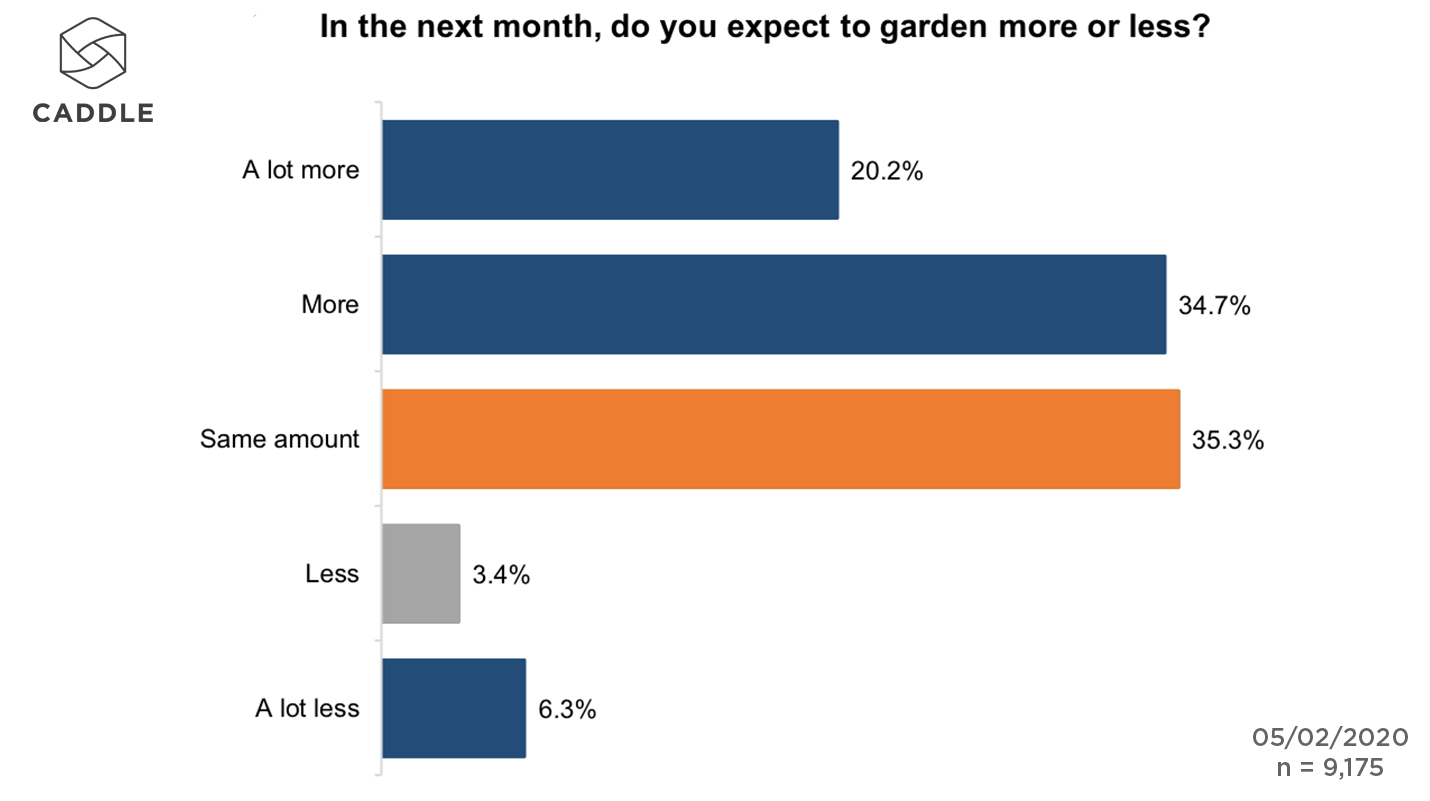
This includes people who say they are unlikely to garden in a typical week.
Despite the pandemic, 59% of our panel said it is likely they will purchase gardening products during the pandemic. Again this includes those who told us they normally don’t garden.
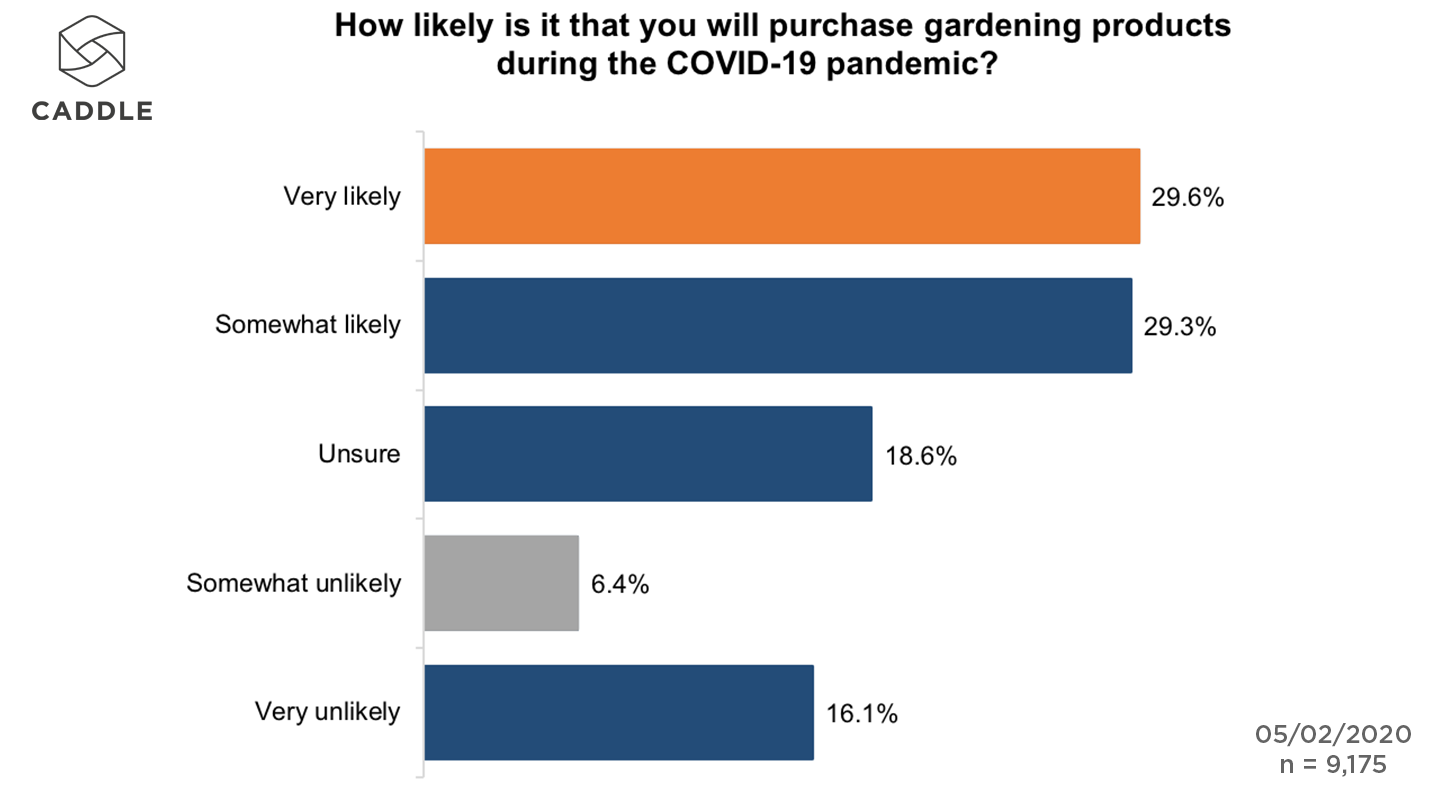
This means that the market is growing for all categories of gardening from plant material, to soil to plant and lawn food. Which retailers will win the battle for the increased demand?
Local nurseries or garden centres are the preferred destination for 40% of those who tend to plant in the spring. This is followed by Costco (14.3%), Walmart (11.7%) and Home Depot (10.7%)

Will Canadian gardeners shop online?
Given the concerns many Canadians still feel about going to places where social distancing is more challenging, will we see more online shopping this year?
Traditionally, shoppers’ preference has been to purchase gardening supplies in-store. However in 2020, we can see that online purchasing is now preferred by almost 40% percent of regular gardeners.
This breaks down as 28.5% preferring buying online with curbside pickup, and a further 10.9% preferring online ordering with delivery.
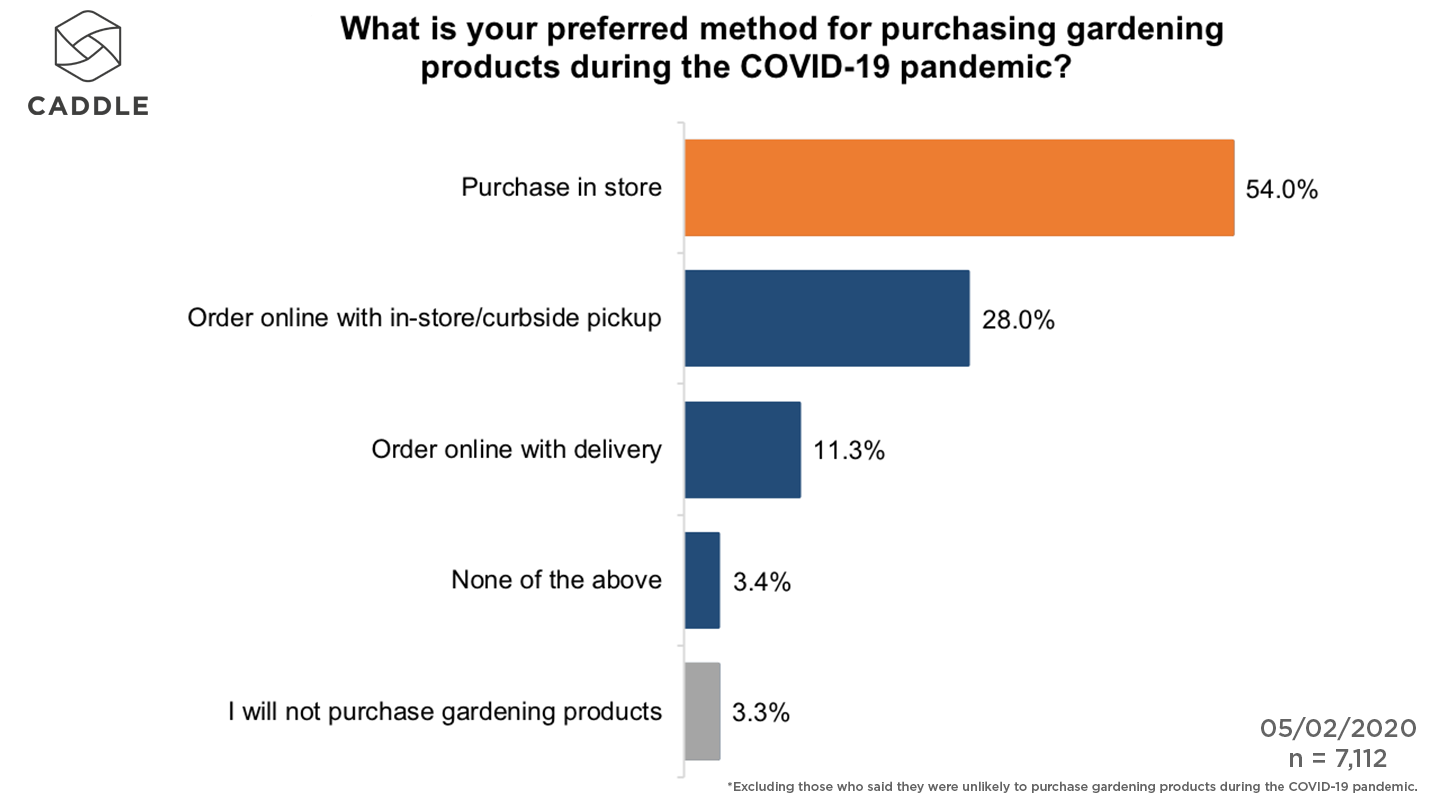
However this still leaves the majority of gardeners who prefer to visit a store to make a purchase.
Excluding those that said they were unlikely to garden in a typical week, we see that the preference among gardeners is still for in-store experiences.
More than half of regular gardeners (54.4%) selected in store as their preferred method of shopping – almost double the percentage that preferred curbside pickup.
Which customers prefer online more?
The biggest factor in which way our panel prefers to shop for gardening supplies is by age group.
Looking specifically at those that indicated they were likely to shop during the pandemic, two thirds of Canadian Baby Boomers prefer in-store shopping, while the number for Millennial and Gen Z Canadians is just under 50%.
What products do gardeners want to shop for online?
Whatever their preference for purchase method, there is consensus on what types of goods gardeners would look to buy online.
Seeds and plants is the top category our panel said they were likely to shop for online, followed by soil, then tools.
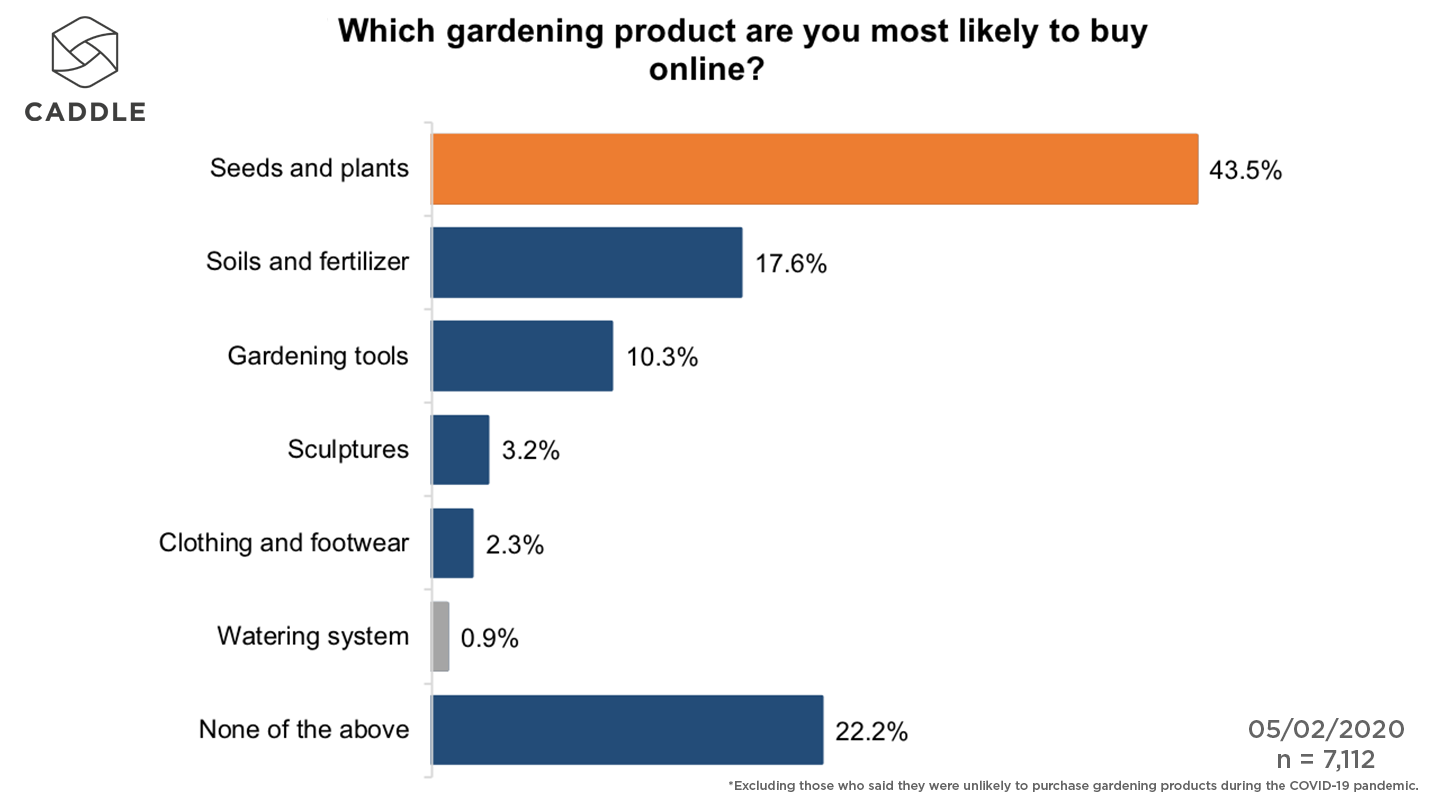
Even among those who said their preference was for in-store shopping 38% said the item they would shop for online would be plants and seeds.
What does this mean?
The split between online and offline means gardening retailers need to cater to both needs at the same time. The majority still favour in store shopping, but a significant minority prefer online.
Failure to offer online shopping, effective curbside pickup or delivery options risks seeing these customers go elsewhere.
On the in-store side, we know from previous research relating to the grocery segment that customers put a high premium on effective social distancing policies.
Almost half of our panel told us they would switch stores if their preferred location was not enforcing social distancing properly.
COVID-19 Insights: We’re Ready For Retail Therapy
-30% Planning Spending Spree In Next Month
COVID-19 restrictions are beginning to be lifted across Canada, but sadness increasingly defines how Canadians feel about their situation.
Caddle has been tracking the emotions felt by our 10,000 member daily survey panel in response to COVID since February. The most recent data shows a 43% increase in the proportion of Canadians reporting sadness associated with social distancing.
But one of the ways consumers are dealing with the COVID blues is by looking to retail therapy as a means to raise their spirits. Nearly one in three Canadians are planning a spending spree in the next month.
Here’s what we learned this week.
(If you’re not already on the mailing list, sign up for our free weekly summary here.)
Social distancing is getting us down
Since the early days of the crisis we have been tracking what emotion our panel most associate with both social distancing and coronavirus more generally.
When we asked on March 18, 57.9% of Canadians chose anxiety as the emotion they most associate with coronavirus. By May 15, this had fallen to 46.4% — much closer to the 41% we recorded on February 29th.
When it comes to social distancing, the picture is one of rising sadness. On March 25, 30.4% of our panel identified sadness as the emotion they most associated with social distancing. This rose to 43.5% when we asked on May 15 — an increase of over 40%.
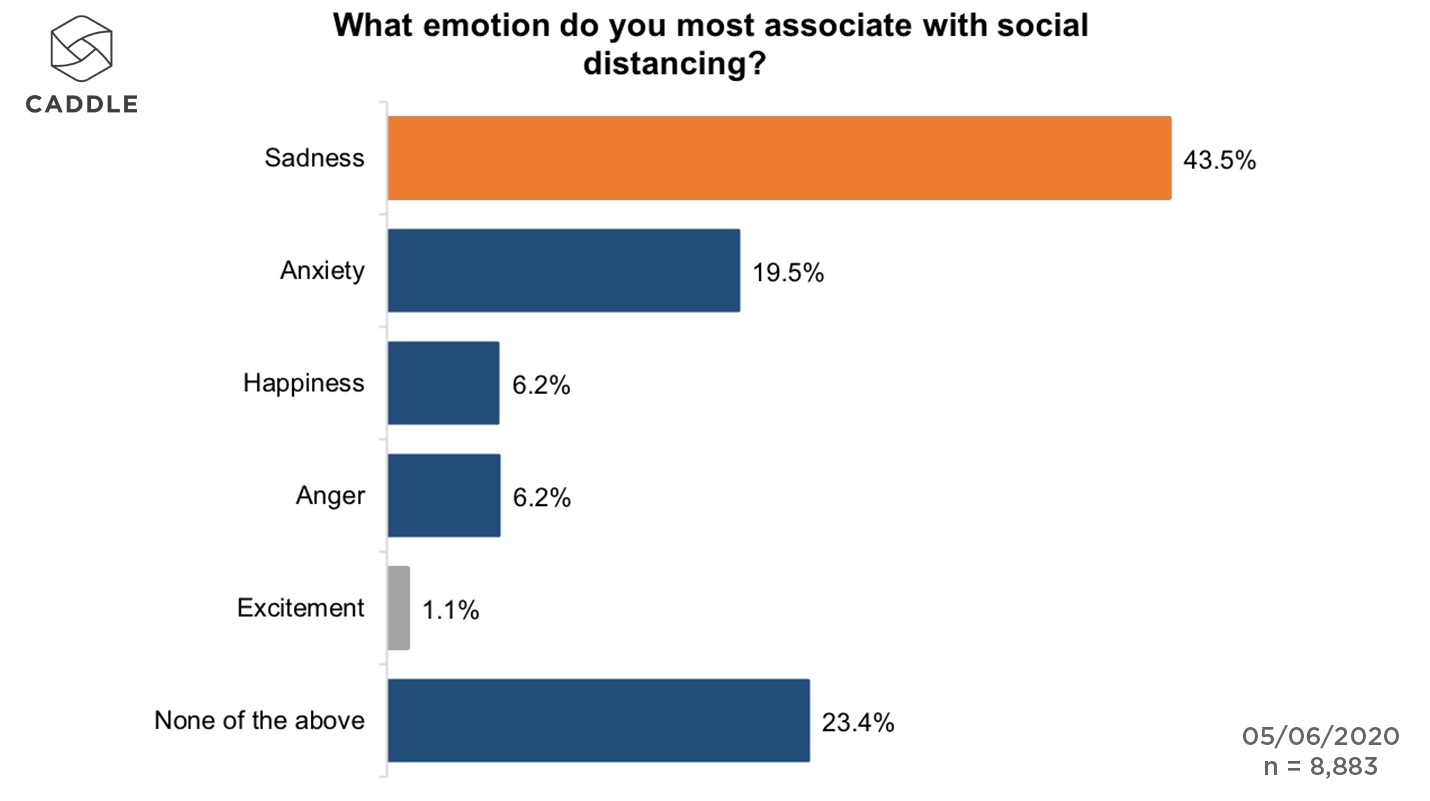
This suggests that over two months of severely reduced social interaction is starting to get Canadians down.
Could a shopping spree help?
It is against this backdrop that we asked our panel about their spending plans in the month ahead.
We found that increasingly there will be a role for shopping as a way to lift Canadians’ spirits through such a tough time.
Caddle data shows that 44% of Canadians look to retail therapy as a means to improve their mood, while 40% of our panel say that a spending spree can make them feel happy or excited.

Now that retail stores are beginning to open up again, our data suggests that this retail therapy will become a significant factor in the next month.
Even in the earlier stages of the pandemic, we had identified this mechanism. At the start of April we learned that a third of Canadians had made purchases they considered a treat or luxury to keep their spirits up during social distancing.
Now, across all respondents on our panel, 31% say they planning an online shopping spree in the next month.
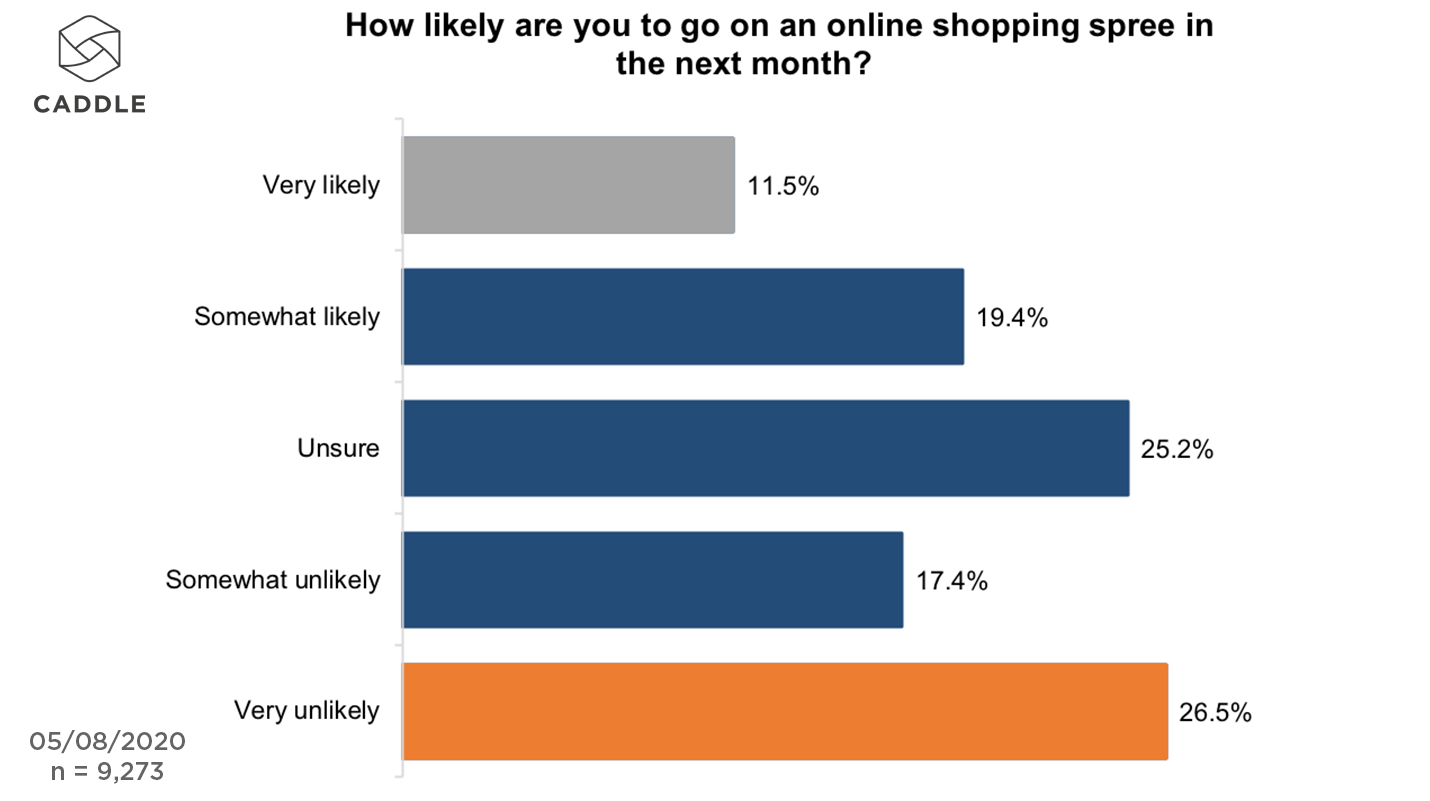
When we look specifically at panel members who told us they use shopping to improve their mood, this rises to 52.7% of people planning a shopping spree in the next month.
Those who are more likely to believe in the morale boosting power of shopping are much more likely to be planning discretionary purchases in the next month.
It is also important to note that we asked specifically about online purchases and asked the question before the announcement that Ontario retail locations would be permitted to reopen on May 19.
What could these shopping sprees look like?
Clothing is likely to be the biggest category to benefit from this trend. Looking specifically at those who told us they were ‘likely’ or ‘very likely’ to go on a shopping spree in the next month, 51% selected this category where they make retail therapy purchases.
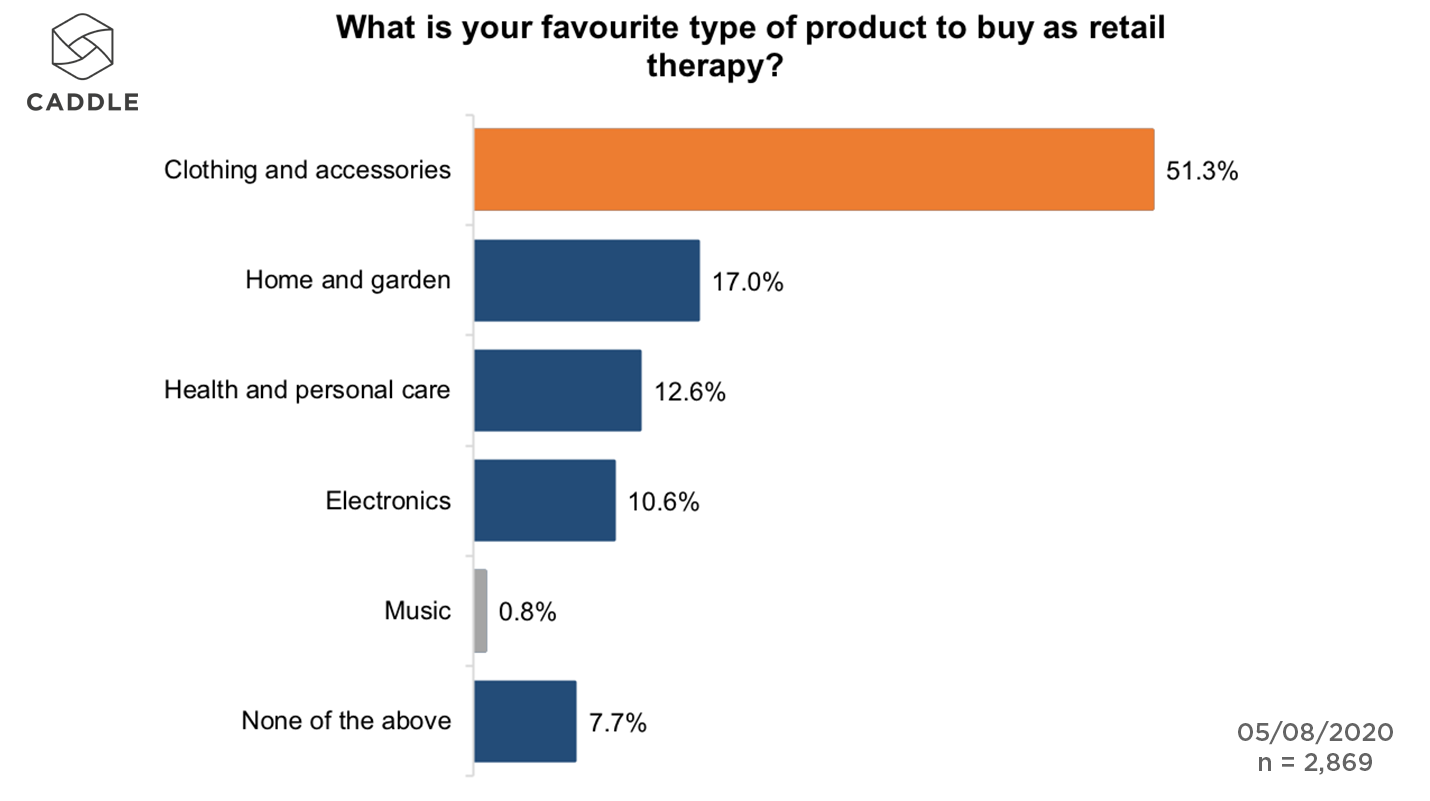
Home and garden was second with 17.0% planning spending in this area.
While clothing is a significant category across all demographics, there are variations elsewhere. Males are just as likely to treat themselves an electronics purchase as a clothing purchase (about 1 in 3), while older Canadians over-index on retail therapy with home and garden purchases (23%).
How much will we spend?
The vast majority of these planned spending sprees will be under $200. 49.9% of those planning a spending spree told us they planned to spend less than $100, with a further 36.4% looking to keep their purchases under $200.
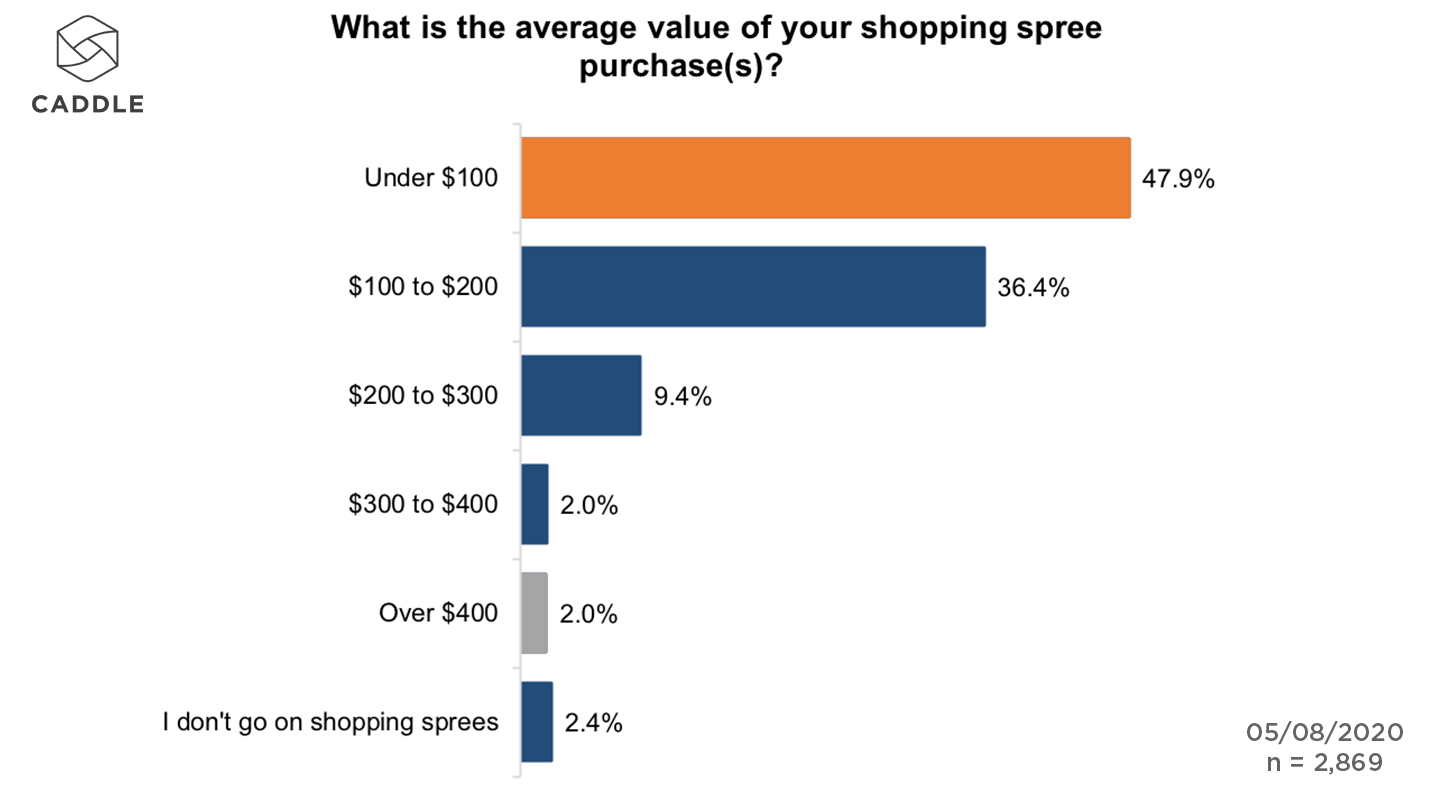
Key Takeaways
We’re moving beyond ‘essentials only’ shopping
Earlier in the pandemic we recorded that cutting back on non-essential items was the key tactic Canadians were using to save money. That a significant minority are now starting to think about discretionary spending sprees suggests we might be moving into a new phase, where consumers feel more confident about making non-essential purchases.
The next month is crucial for online vs in-store
This data showed a third of Canadians planning an online shopping spree. However as stores begin to reopen, will these purchases migrate in store instead? Where this spending ends up taking place will be a significant indicator of the role eCommerce will play in the medium term in Canada
We’re ready for positive vibes
Despite the rising reports of COVID-related sadness, this data suggests that many Canadians are looking for those moments of joy and positivity. This is no doubt boosted by some restrictions starting to be eased. We’re looking for things that will lift our mood and there is an opportunity for brands to be part of that positivity.
COVID-19 Insights: Fast Food’s Trust Issue
59% concerned about contaminated packaging
The ability to reopen safely can’t come soon enough for Canadian restaurants of all sizes. But when they open, will consumers go?
We know from Caddle data that the consumer return to restaurants will be gradual, given concerns around social distancing. But as quick service restaurants explore how to make reopening work safely, we have found there is another dimension to the issue.
The results from our 10,000 daily survey panel members show that concerns about fast food extend beyond standing close to others in a busy restaurant.
How has COVID impacted fast food consumption?
Despite the slowdown in restaurant purchases, previous Caddle data has suggested some positive signs for fast food.
Canadians still look for quick and easy options for their meals and have reported a shift towards eating more comfort food. Yet with restaurants closed save for drive-through or delivery, this has not translated into higher consumption.
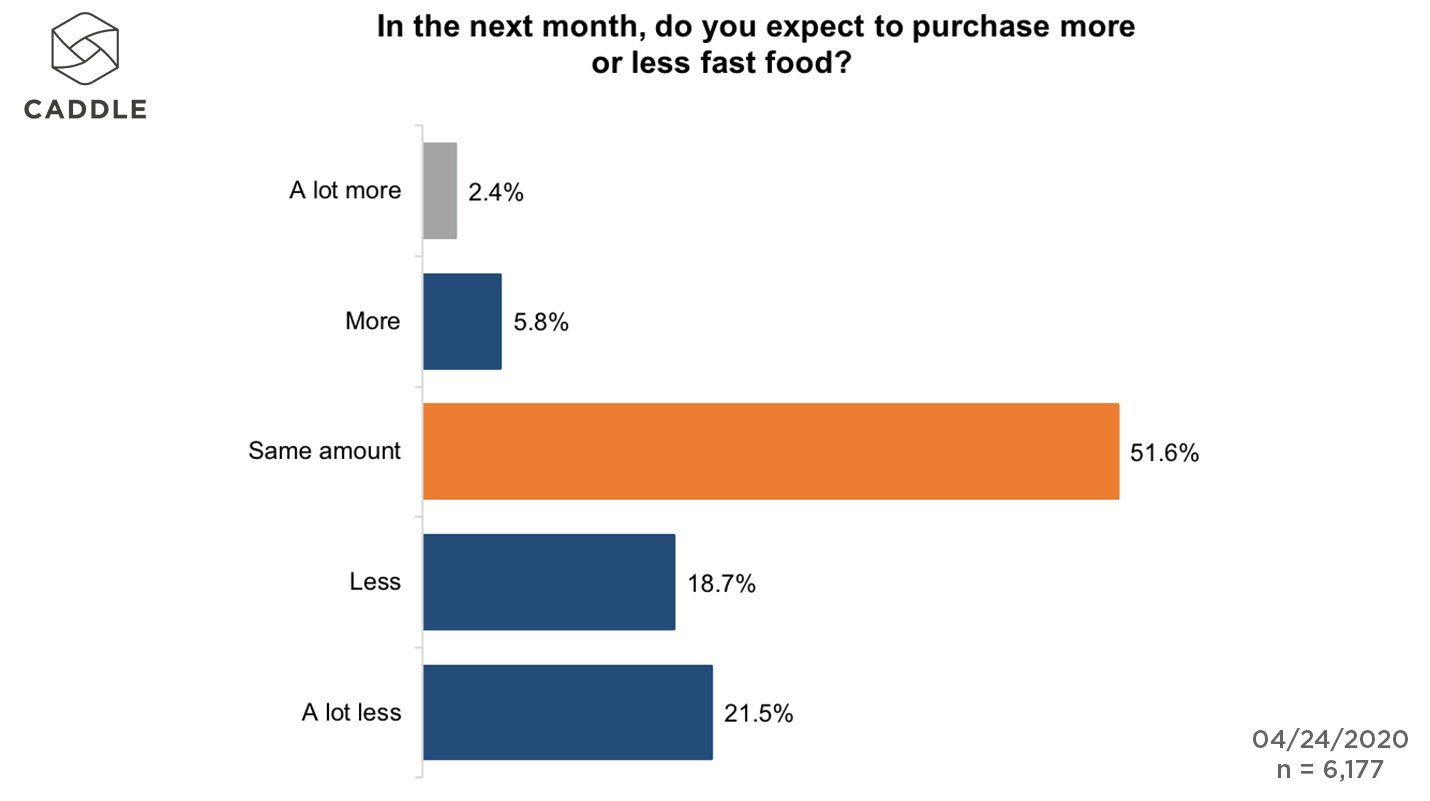
Just 15.5% reported they had been eating more fast food since measures to limit the spread of COVID-19 were introduced. On top of this, 40% said they expect to order less fast food in the month ahead.
Why are we ordering less?
The reduction in foot traffic from the closure of locations, coupled with a tightening of many consumers’ budgets would logically have an impact on consumption. However our data suggests another dimension to add to the mix; the safety of the product itself.
59% of the Caddle panel told us they were concerned about fast food packaging being contaminated. Meanwhile 65% disagreed with the statement that ordering fast food was the safest way to eat during the pandemic.

Customers are unconvinced that employees at fast food restaurants are observing social distancing measures. Over a quarter of respondents (27.3%) say they don’t think restaurant staff are observing social distancing protocols, compared to 18.7% who believe they are.
The one silver lining is that there was a net positive score on the issue of sterilization. 35% of our panel said they believed restaurants were implementing effective sterilization procedures, compared to 19% who thought they weren’t.
Do we trust food delivery?
These concerns about safety do not appear to extend to the delivery of fast food. Just over 42% of the panel said they were likely or very likely to trust food delivery services during the pandemic. This compares with 26% saying they were unlikely to do so.

This hints at a significant issue for restaurants to address: consumers’ concerns with safety appear to be more directed at the in-restaurant procedures rather than the delivery process.
This means it is not a concern that will go away when restaurants are able to reopen. Brands will have to work hard to convince customers not just of the safety of coming into the store, but that behind the scenes proper measures are in place for food preparation as well.
Who is eating more fast food?
There’s no getting around the fact that most people are ordering less fast food, and envisage that being the case in the near future. But what of the people who told us they are ordering more?
This group makes up just under one in six of our panel. In a challenging situation, it is vital that brands find these people and communicate with them effectively.
So who should they be targeting?
Two key groups we have identified are younger males, and parents with more than two children. Both have higher proportions of respondents who said their fast food consumption had increased. However, these are still not groups where the majority report higher consumption overall.
In the case of younger males, 28% of those who eat fast food said they were consuming more as a result of the pandemic, compared to 15.5% in the panel overall. Likewise 17% say they expect to purchase more fast food in the next month — more than twice the 8.2% for the panel as a whole.
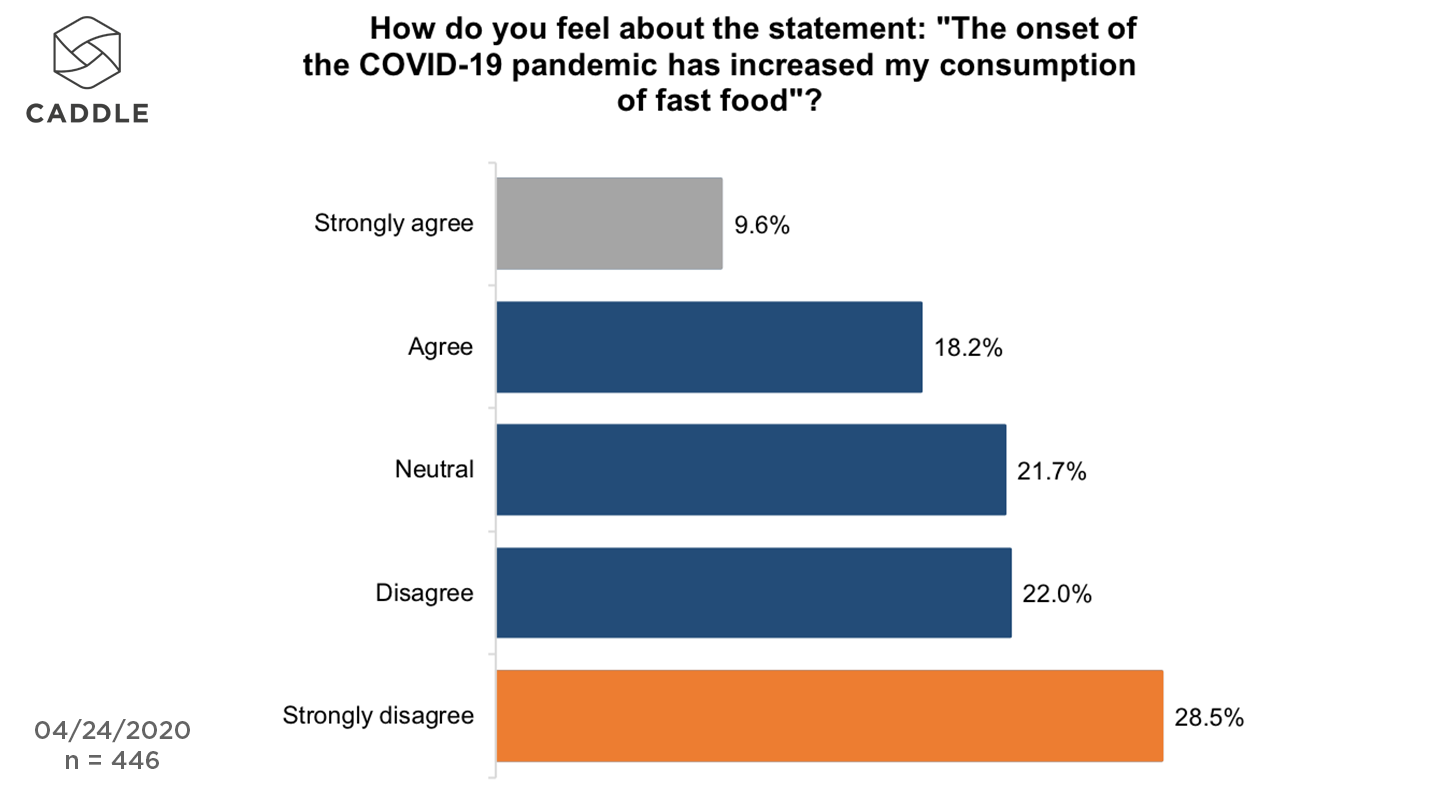
For parents with more than two children under the age of 18, 14.8% said they anticipated buying more fast food in the next month while 23.4% reported opting for fast food more since the start of the pandemic. In both cases the number filters out parents who indicated they did not eat fast food.
What’s driving purchase?
For these groups and the panel more generally, convenience remains the key to QSR purchases. Over 50% of those who usually consume fast food cite convenience as they top reason for purchase during the pandemic.
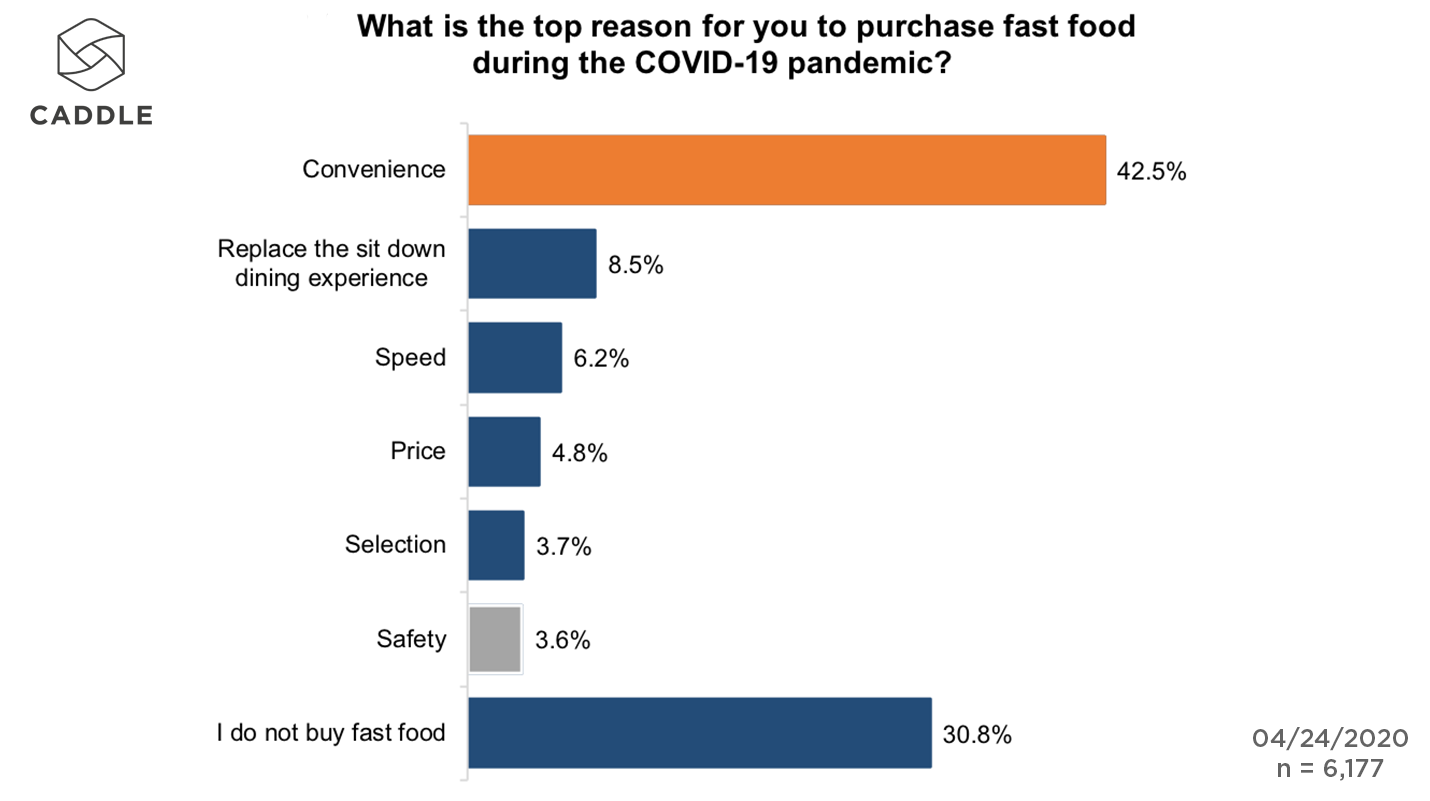
Key Takeaways
1. Communicate Safety In Every Area
The importance consumers put on COVID-19 safety should never be underestimated. This data shows clear concerns when it comes to fast food. These extend well beyond the enforcement of social distancing within restaurants once they re-open. Brands need to communicate what is happening in areas such as food preparation to reassure customers.
2. Offer convenience, but not at any cost
Customers clearly value the convenience QSRs offer. The more a restaurant opens up the more convenient it can become. However, there is a limit to how far brands can go. Our analysis in other segments suggests responsible social distancing policies could themselves become a driver of purchase decisions.
3. Dig into growth segments
Not everyone is cutting back on fast food. As this data shows, the situation created by the pandemic is leading to increased consumption for some groups. Even as restriction ease, brands need to focus on understanding and reaching these segments.
